Ethical and purpose-based business practices are quickly becoming brand identifiers, on par with quality, craftsmanship and service, as luxury buyers turn increasingly conscious of their environmental footprint.
Transparent sustainability and corporate social responsibility (CSR) policies are much more than a passing trend or a once-per-year obligation mentioned only on Earth Day – these measures have become luxury’s new cornerstones. With heightened eco-friendly awareness stemming primarily from millennials, luxury brands must approach CSR as a non-negotiable service to society, rather than a public relations-motivated stunt.
“Consumers do not understand what the word ‘sustainability’ really means, yet they care what the word sustainability encompasses,” said Diana Verde Nieto, CEO of Positive Luxury, London.
“From fairness to animal welfare, from transparent company governance to diversity and inclusion, the consumer cares about all of these,” she said.
“Companies that are behaving – not just talking – in a way that demonstrates their commitment toward any of those and beyond are the ones that consumers will choose, especially the younger ones.”
5 key sustainability touchpoints
- Materials
From diamond mining to farmed leathers, the social and environmental impact of sourcing materials for luxury goods has grown in importance. Conflict- and cruelty-free sourcing is appealing to consumers who do not wish to harm others or the environment with their purchases. Also, textile alternatives, upcycling and the circular economy are growing in popularity among luxury brands.
- Production
Questions of how and by whom a product is created are also of interest for luxury buyers. Consumers are increasingly concerned with working conditions for employees and how the manufacturing process may affect the community and environment.
- Footprints
Similar to consumer concerns of lessening their individual footprint, luxury brands have stressed the importance of green selling spaces and low-impact manufacturers. There has been an increased focus in lowering brands’ carbon footprints and ensuring spaces are Leadership in Energy and Environmental Design (LEED)-certified.
- Education
Luxury brands have begun sharing sustainable best-practices through educational initiatives. Passing this knowledge on to luxury’s next generations will ensure a greener tomorrow.
- Transparency
Consumers’ increased awareness of CSR and environmental policies has spurred transparency from luxury brands. Now, if a brand does not share its eco-friendly practices publicly, consumers may decide on a brand that puts its green foot forward during a purchase decision.
Responsible and aware
Consumers are now more socially aware than in the past and most prefer to shop brands that are transparent and operate sustainable businesses.
Per Positive Luxury’s 2017 Predictions Report, today’s consumers are mindful of the quality and craftsmanship of luxury products, and receptive to storytelling efforts that tell of a brand or good’s origin.
While luxury is well-versed in communicating these pillars, the most successful brands are just as technologically adept and social media-fluent as consumers. What is more is that consumers are looking for brands and products that are “agents of positive change and growth in society” (see story).
Research from The Future Laboratory, which tracked the five stages of luxury consumption, found that 15 percent of luxury consumers are currently in the “Responsible and Aware” stage.
These individuals are most concerned about the impact of the goods they are buying. They seek out brands that care about doing good, particularly in topics surrounding the environment.
Millennials make up 41 percent of this subset, making it an important target audience for the future (see story).
The heightened concern with a business’ green practices can be attributed to millennials’ tendency to be values driven, meaning the generation’s decisions are often based on the resulting impact of their actions, lifestyles and purchases.
“In surveys, people have long indicated that they want more sustainable products,” said Andrew Winston, strategy consultant and author of The Big Pivot and Green to Gold, Greenwich, CT. “When and how that translates into different buying behavior is the big question.
“In general, the questions about products and services are rising: Where did this thing come from? Who made it? Is it healthy for me and my kids? And on and on,” he said. “It's easier to see the pressure building in products like food and personal care – and thus the luxury ends of those markets – but might not be as clear in other luxury products.
“That said, while many consumers may not think of what they want in products in terms of ‘sustainability’ or ‘socially-responsible,’ they may demand things that fit the definition.
“For example, the pressure on jewelry to avoid 'conflict' areas is a rising expectation,” he said. “Or that apparel comes from organic or renewable materials. More people expect these attributes today, and that's especially true for millennials.”
The color of money
The gravitation toward sustainable brands is not exclusive to consumers.
According to Positive Luxury and the Luxury Institute’s 2016 findings for its joint Predictions for the Luxury Industry: Sustainability and Innovation report, C-suite executives have found that to keep brand value and continue growth, an investment in sustainability performance and practices is a must.
While there has been growth in marketing efforts boasting sustainability practices and an increase in transparency as to how products are manufactured, there has also been higher demand from investors for sustainable businesses.
Nearly half of CEOs surveyed in 2016 agreed that climate change and resource scarcity will transform their business, making environmentally-sound choices even more significant (see story).
“The positive correlation between corporate sustainability performance, specifically related to environmental, social and governance issues, and financial performance has been increasingly linked, and therefore it's shown that socially-responsible brands produce greater shareholder value,” Positive Luxury’s Ms. Verde Nieto said.
“The goal of any investor is to grow their invested capital – in other words, make money,” she said. “As Warren Buffett has said, his preferred time to hold a stock is forever. He also advises to only buy something you’d be perfectly happy to hold if the market shut down for 10 years.
“[Mr. Buffett] is championing long-term investment, something that companies who are investing and integrating sustainability into their corporate strategies are able to deliver.”
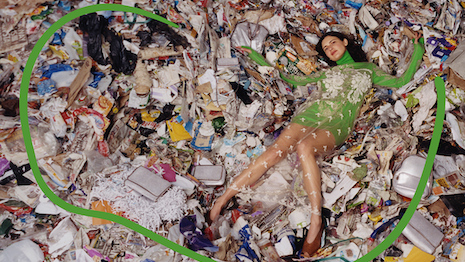
Stella McCartney's fall/winter 2017 campaign tackled wastefulness. Image credit: Stella McCartney
The journey toward sustainability has also created a new pillar for luxury brands to consider in their marketing communications.
Efforts that rely on brand storytelling, education and humanity have been leveraged by luxury brands to share their sustainable choices. These authentic displays of pride in sharing and promoting these values have indeed become a selling point for many consumers.
In turn, consumers who are aware of a brand’s sustainability efforts are more likely to remain loyal and return for future interactions (see story).
Trickle-down sustainability
Given transparency’s importance in the minds of consumers, the ways in which brands communicate their positive impact has also grown. This has led many luxury goods conglomerates to push sustainability as an intrinsic part of company culture at the group level.
The luxury group’s commitment causes a trickle-down effect embraced by brands within the portfolio and encourages individual houses to align with the conglomerate’s overall CSR culture.
Consistently, the most vocal of luxury’s groups have been France’s Kering and LVMH.
Kering, for instance, has been recognized as a climate change leader by CDP’s annual “Climate A List” ranking. Kering is among only 5 percent of global companies to receive an A-grade from the international nonprofit that encourages companies and governments to reduce greenhouse gas emissions and protect water resources and forests.
CDP created the Climate A List at the request of 827 investors with assets of more than $100 trillion (see story).
Kering 2025 : Crafting tomorrow's luxury
For the third year running, Kering was also named the most-sustainable company in the luxury sector by the Dow Jones Sustainability Index (DJSI), which recognizes brands that are leaders for their overall environmental and social performance and is considered a leading benchmark for corporate sustainability (see story).
Kering is vocal and proud of its environmentally friendly and ethical business practices. Since 2015, Kering has publicly shared the methodology behind its sustainability through its open-sourced Environmental Profits & Loss (E P&L) accountability report (see story).
Similarly, LVMH annually partners with the European Commission for Green Week to share best practices in biodiversity.
LVMH has developed sustainable environmental policies for the houses under its umbrella for the past two decades, including the preservation of natural raw materials used to make its luxury goods.
In 2015, LVMH joined the European Business and Biodiversity Platform as a strategic advisor to the European Commission (see story).
To celebrate 25 years of environmental achievements, LVMH has set new goals, known as “LIFE 2020,” for itself and the 70 brands under its umbrella.
LIFE 2020’s objectives are centered on four pillars: products, sourcing, supply chain and CO2 sites. The goals are not designed to be simply met, but exceeded.
The group’s initial target of using 10 percent renewable energy, for example, has already been achieved and increased to 30 percent by 2020. The conglomerate hopes to reduce its CO2 emissions by 25 percent compared to 2013.
LVMH also has plans to double its internal carbon funds next year. Since 2016, LVMH has invested approximately $7.9 million into its internal carbon funds (see story).
LVMH internal carbon fund: A 1-minute tour
Other groups, such as Switzerland’s Compagnie Financière Richemont as well as individual brands including Burberry and Versace, are not as outspoken, but still publicize their company’s ethical and sustainability codes and commitments on their corporate Web sites.
Mission and methods
While sustainability efforts are rooted in the same causes, such as limiting emissions or conserving water, each sector approaches green practices differently and in ways that apply to its manufacturing process and final product.
Here are some of the many CSR methods and policies enacted by luxury’s primary sectors.
Apparel and accessories
According to Andrew Morgan’s documentary “True Cost,” the pollution created by the fashion industry is surpassed only by the oil industry.
Fashion brands are uniquely positioned to spearhead change. Many luxury brands, to some degree, have developed sustainable and ethical supply chains, simply because these qualities are integral to what it means to be a luxury house.
Luxury is partly about craftsmanship and high-quality materials, two things that ought to be done in an ethical and sustainable manner, because otherwise a brand's integrity is stained (see story).
To this point, textile creation has been a focus of brands’ strategies to curb pollution and develop more sustainable methods.
Kering, for example, organized an ideas accelerator with Fashion For Good and Plug and Play in March.
With a focus on textiles, Plug and Play - Fashion for Good’s overall goal is to assist Kering and its brand stable to spark disruptive innovations that will transform traditional luxury processes. The innovations will further Kering’s commitment to the widespread adoption of sustainable business practices (see story).
Production transparency has also been explored by fashion brands hoping to reassure consumers that their products’ raw materials, such as wools, are responsibly sourced.
LVMH-owned Loro Piana, for example, developed a material sourcing method for its cashmere wool sourced from goats in China’s Alashan region.
The “Loro Piana Method,” based on five years of research surrounding cashmere production, has enabled breeders in Alashan to combine higher-quality wools with sustainable development. As a result, Chinese breeders need to rear less goats, but keep a high annual volume.
Furthermore, standard of living improved and the natural balance between the animals and their habitat has been rekindled through a reduction of desertification in the area (see story).
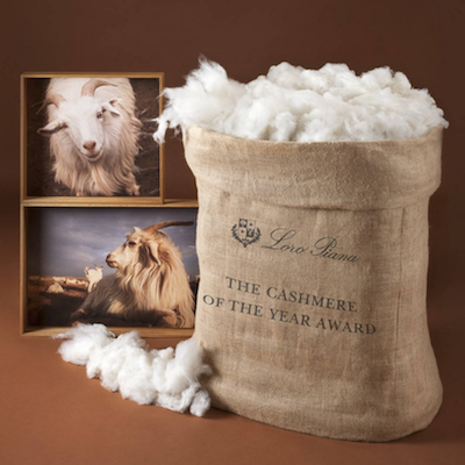
Loro Piana cashmere comes from goats in China's Alashan region. Image credit: Loro Piana
When these methods come into question, brands must be quick to respond or risk their responsible reputations.
In 2015, People for the Ethical Treatment of Animals (PETA) brought to Stella McCartney’s attention that one of its 26 sustainable wool producers from Ovis 21 in Patagonia, Argentina was mistreating the sheep on its farm.
Ms. McCartney built her fashion brand through sustainability practices and without the use of any leather, fur or animal skins, causing PETA’s report to go against the Kering-owned label’s core DNA.
In response, the designer quickly issued a statement on Facebook to ensure its consumers that ties were severed with the Ovis 21 source mistreating its sheep.
After launching its own investigation, the brand concluded that one sheep harmed “is one too many” (see story).
To this end, many brands have announced they will discontinue the use of furs in designs. Following Giorgio Armani and retailer Yoox Net-A-Porter Group, Gucci joined the Fur Free Alliance as as part of its larger decade-long sustainability plan (see story).
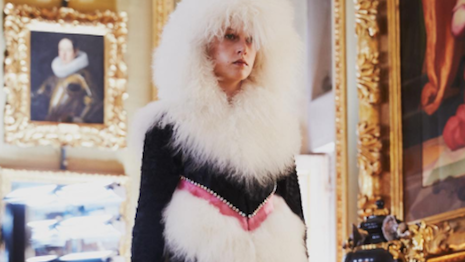
Gucci cruise 2018 look. The brand has become the latest to give up fur. Image credit: Gucci
Equally cruel to an animal, leather and exotic skins remain in use by a majority of luxury brands, much to PETA and other animal rights groups’ chagrin. To make its position clear, PETA has even purchased stock in LVMH to curb the group’s use of exotic skins (see story).
“Fur and alternative leather are just one of the issues in the wide range of the obstacles that fashion as an industry has,” said Yana Bushmeleva, chief operating officer of Fashionbi, Milan.
“To reduce the ecological harm and wastefulness, it is important to analyze all the phases starting from the growing of the raw material till the final consumption of the product,” she said. “The consumer plays one of the key roles.”
Increasingly, luxury fashion houses have begun to explore the development of textile alternatives or have swapped authentic leathers for artificial substitutes.
But the move toward artificial substitutes, especially faux furs and leathers, does come with a downside as the production of these petroleum-based fabrics is detrimental to the environment, as well as being disruptive to an established supply chain (see story).
A better and sustainably-sound solution may be found in natural fibers and lab-grown alternatives.
Ferragamo, for instance, designed a collection using fabric derived from citrus fruits that is similar in look and feel to silk.
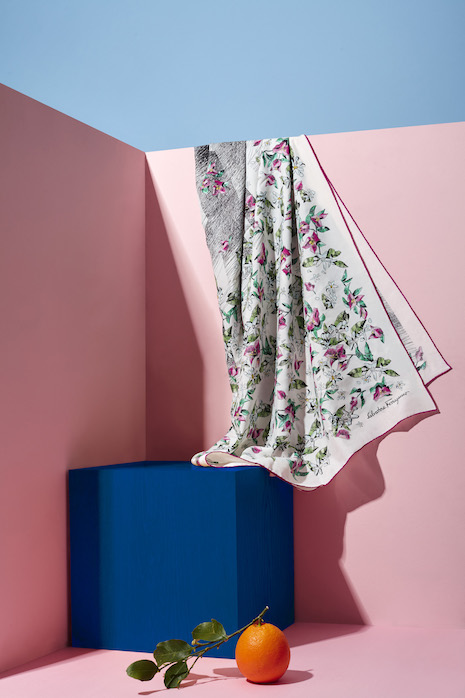
Citrus fruit can be transformed into a silk-like twill. Photo courtesy of Ferragamo
The sustainable fabric begins with the peels of citrus fruits after they have been juiced. In Italy alone, discarded fruit rinds create more than 700,000 tons of by-product (see story).
Likewise, Stella McCartney inked a partnership with Bolt Threads, a biotechnology company, to advance and innovate the manufacturing of textiles.
The first collaboration yielded a vegan spider silk made from yeast, which the British designer used to create a one-off gown shown at the Museum of Modern Art in New York during the “Items: Is Fashion Modern?” exhibit (see story).
If biodegradable textiles are used, waste can be drastically reduced. According to the Environmental Protection Agency, U.S. consumers alone produced 15.1 million tons of textile waste in 2013.
While most of the blame falls on fast-fashion consumption, luxury brands have tapped into upcycling and recommerce to do their part in lessening the amount of textiles filling landfills.
Burberry, for example, has entered a partnership with Elvis & Kresse that will see at least 120 tons of the house’s leather scraps transformed into accessories and home goods. The leather industry makes about 800,000 tons of waste per year, most of which is typically destroyed (see story).
With concerns about the environmental impact of the apparel business rising, secondhand sales are one tactic to combat the fashion’s footprint.
Stella McCartney and high-end consignor The RealReal have teamed to market the reusability of luxury fashions, prompting consumers to get on board with the circular economy (see story).
“The amount of the bought products and the way how we care for the clothes has a direct impact as well,” Fashionbi’s Ms. Bushmeleva said.
“For example, a customer who owns a fur coat can be more eco-friendly than the customer who buys a pair of new jeans on monthly basis and washes them in warm water once in a week,” she said.
“Overconsumption and overproduction cannot be sustainable. We need to receive a proper education on how to behave in order to live a more sustainable life on all the levels.”
Fragrance and beauty
Perfume and personal care brands commonly support the habitat, flora and apiary sources of their raw materials.
Similar to fashion’s dedication to textile quality, the ingredients incorporated into luxury fragrances or skin care products speak to a brand’s stature among its competitors.
Estée Lauder Cos.’ Crème de la Mer, for instance, often hosts branded conservation efforts to protect the world’s oceans, where it sources much of its skincare ingredients.
La Mer’s dedication to improving ocean conservation efforts has resulted in the brand donating more than $2.6 million to its cause since 2008 (see story).
Importance of Ocean Conservation with Margaret Zhang | Blue Heart | La Mer
The protection of central ingredients is leveraged by many brands, especially if the raw material is rare or endangered. For ingredients in the latter category, spreading awareness and promoting sustainable use is a common tactic.
French perfume house Fragrance Du Bois, for example, promoted the sustainable use of oud, a resinous heartwood and key ingredient in many perfumes, by producing a song in collaboration with Arab singer Nadeem Nour.
Oud is found in Aquilaria and Gyrinops trees in Southeast Asia and the Middle East, but unfortunately it is available in limited quantities and an increasing illegal trade has now threatened to make it extinct. Because oud is used in many perfumes and incense, the demand for it is very large and outstrips the supply (see story).
On the heels of the European Commission’s 2017 Green Week, French perfumer Guerlain similarly shared its ongoing commitment to protect its brand motif, the bee, and biodiversity at large.
While vital for agriculture, the declining bee population has proved detrimental to flower fields. As a traditional perfumer, which relies on sourcing the world’s best ingredients, Guerlain is deeply invested in ensuring the world’s bees can bounce back from the brink (see story).
Universités des Abeilles/Bees Universities - Laurent Boillot - Guerlain
France’s Clarins Group has also taken agriculture into consideration. Farming has its own environmental impact that brands sourcing raw materials must take into account.
Clarins Group’s Parfums Mugler recently announced its plans to become a sustainable pioneer in the fragrance space by using responsibly developed alcohol in its perfumes. Part of Clarins Group’s Made in France initiative, the effort aims to produce a perfume alcohol that meets stringent environmental and social requirements.
The program, the first of its kind for the fragrance sector, will promote biodiversity in agricultural products. This effort benefits the local production and the supply chain between harvest and transformation sites (see story).
Jewelry and watches
The jewelry industry has been directly impacted by consumers’ concerns of worsening miner and environmental conditions through its purchase of diamond, gemstone or precious metals.
Swiss jeweler Chopard has been forthright in sharing its sustainability journey with consumers.
In 2016, for instance, Chopard entered an eco-conscious partnership with colored-gemstone miner Gemfields to further its “Journey to Sustainable Luxury.”
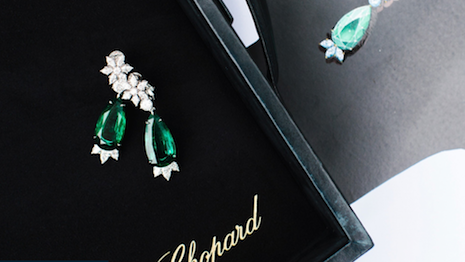
Chopard earrings with Gemfields emeralds. Image credit: Chopard
The partnership sees that the emeralds used in Chopard’s jewelry, and sourced by Gemfields, are validated by Eco-Age’s Green Carpet Challenge (GCC) Principles of Sustainable Excellence. Chopard jewelry also uses ethical, Fairmined-certified gold sourced from artisan and small-scale miners (see story).
Similarly, De Beers’ Forevermark reassures consumers of the sanctity of their purchase by providing each of its diamonds with an individualized supply chain timeline.
Forevermark promotes the transparency of its ethical diamond sourcing and pipeline through its identification inscriptions that tell the of a stone’s journey from discovery at the mine all the way to its arrival at a retailer’s point of sale.
Also, Forevermark takes pride in its business initiatives that give back to diamond-producing communities, the environment and its protection of biodiversity. For diamond-producing communities, this includes healthcare, education and business loans for local entrepreneurs (see story).
The promise & inscription | Forevermark
Diamond sourcing, in particular, is often called into question due to concerns of environmentally harmful mining practices paired with alleged social injustices of those working in the mines.
As consumers become increasingly aware of these issues, many have opted to steer clear of diamonds, especially millennials, as they do not wish to purchase or support anything that may weigh on their conscience.
Lab-grown diamond alternatives have grown in popularity. These lab-grown stones are molecularly identical to what is mined from the Earth, but without the same level of environmental and social complications (see story).
As for the horology sector, watchmakers such as Richemont’s Baume et Mercier have lessened their environmental impact by leveraging a circular economy that reuses materials such as metals.
Taking cues from fashion, Baume et Mercier also uses rainbow trout-derived Banka leather rather than bovine or exotic hides for its Petite Promesse watch straps.
The trout are farmed in a river habitat in the Basque region where “animal welfare ranks above productivity.” The fish’s physiological needs are met by clean, well-oxygenated water through an avoidance of antibiotics or vaccines and responsible weather-based feedings.
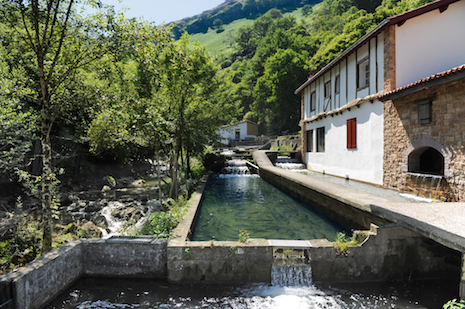
French fisherie where Baume et Mercier sources its Banka leather. Image credit: Baume et Mercier
Prior to the development of Banka leather, the trout skins were discarded as the fish were being prepped for high-end restaurants in the area.
"There is no doubt that all brands need to have a mindful approach when creating goods or services," said a spokesperson for Baume et Mercier. "It is a complicated topic, but necessary for the success of brands moving forward as well as the future of our communities.
"For Baume & Mercier, creating the Banka leather straps was our first public showcase of our efforts to explore alternative materials and there will be more to come at SIHH 2018 and beyond," the spokesperson said. "Some examples include using salmon skins for feminine watches.
"Aside from product launches, Baume & Mercier is working on much larger projects to increase our efforts and become a key player and example in creating a circular economy. 2018 will be an exciting year of news in this respect. However, nothing can be shared at this time.
"Though Baume & Mercier is one of the oldest watch brands in the industry, we are also one of the most dynamic. We can adapt easily to new trends or global efforts and that is exactly what we will do when it comes to sustainability."
Retail
Retailers also actively participate in green initiatives, often curating likeminded brands for their stores, and working to diminish the environmental footprint of bricks-and-mortar locations.
While certainly not alone in its efforts, British department store Selfridges has been a champion of sustainable retail, believing that its CSR programs are a non-negotiable service to society and a way to instill trust among consumers.
In 2016, Selfridges was recognized by its peers for its efforts and was the recipient of the inaugural World’s Best Sustainability/CSR Campaign by A Department Store Award given by the Intercontinental Group of Department Stores. Selfridges will retain its title until 2018 (see story).
The retailer runs a number of campaigns within its stores that limit its environmental impact such as the elimination of in-store plastic water bottles and a program that recycles its eateries’ used coffee cups to create its yellow shopping totes.
Selfridges Project Ocean
In terms of merchandising, Selfridges’ commitment is demonstrated by its buyers and their personal knowledge of sustainable practices. Selfridges’ buyers make sure to ask brands and manufacturers not just a straightforward “Are you sustainable?” but more impactful questions that inquire about sourcing, supply chain and business practices.
Transparency is also extended to Selfridges’ signage, which includes Positive Luxury’s Butterfly Mark, an indication of a sustainable brand.
Selfridges even goes as far as to promote sustainable materials such as cotton, considered one of the most environmentally-friendly textiles, and brands that are members of the Better Cotton Initiative, to assist consumers in making better purchase decisions (see story).
Selfridges Hot Air: Material World
Spirits
Similar to efforts put forth by personal care brands, distillers and winemakers are equally dedicated to the environment where ingredients are harvested.
LVMH’s Hennessy, for example, started acquiring green vehicles and delivery trucks in 2011 and now operates the largest fleet of electric automobiles in any private business in France. Likewise, Moët & Chandon took an electric view on production by using a fleet of T4E electric tractors as a way to eliminate emissions and protect its vineyards (see story).
Noting the harm that manufacturing has on the environment, Scottish distiller Glenmorangie launched a two-fold project to clean the wastewater produced during the whisky-making process.
Glenmorangie’s projects work to purify and clean the waters near the brand’s distillery on Scotland’s coast by reintroducing native oysters and opening an anaerobic digestion plant (see story).
Upcycling waste products has also been explored by spirits makers. LVMH Champagne house Veuve Clicquot, for example, has created eco-friendly packaging that repurposes leftover grape skins.
Veuve Clicquot’s Naturally Clicquot
The bio-based material is then used for Veuve Clicquot’s innovative packaging, which is a Champagne bottle case that is 100 percent biodegradable and recyclable (see story).
Travel and hospitality
Linked to consumers’ interests in experiential travel, a desire to visit eco-friendly and responsible hotel properties has recently grown.
Efforts range from properties being mindful of water waste and limiting carbon footprints to programs to protect biodiversity.
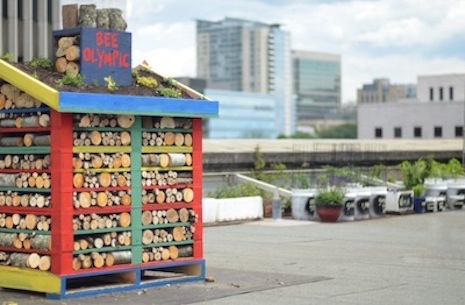
A number of Fairmont Hotels & Resorts have "bee hotels" on their roof tops (see story)
In 2015, the Waldorf Astoria and The Peninsula were among New York hoteliers to pledge their support in the fight against climate change.
Sixteen of the city’s iconic hotels joined Mayor Bill de Blasio’s NYC Climate Challenge, promising to lower their greenhouse gas emissions by at least 30 percent within the next 10 years. Sustainability is on the minds of many travelers these days, making participation not just a worthy cause, but also a selling point and differentiator (see story).
Consumer interest in green hotels has even inspired the launch of eco-friendly brands such as SH Group’s 1 Hotels.
The three-year-old 1 Hotels is a mission-driven hospitality brand that works to show that sustainability can be a beautiful, luxury experience without lowering the expectation bar or coming off as too “crunchy.”
With sustainability as its foundation, 1 Hotels has seen goodwill expressed by its guests due to its transparency, whether the results were good, bad or ugly.
Discover 1 Hotels #Explore1Hotels
Guests are able to explore 1 Hotels’ online dashboard that tracks each property's water usage and waste or a particular room’s consumption during a stay.
The level of transparency, even if water usage is up, for example, becomes a telling narrative that guests are able to interact with and celebrate in the hotel’s success, all while legitimizing its approach (see story).
Automotive
Automakers have been proactive in exploring various forms of mobility to combat climate change and respond to consumer interest in lessening their carbon footprint.
Thanks in part to government mandates to reduce emissions and a movement to transition away from petrol and diesel models altogether, electric vehicles are no longer a futuristic concept with nearly all automakers creating an electric or hybrid option.
In 2016, Norway announced plans to ban petrol vehicles by 2025 (see story). Both India and China, countries with severe pollution, have pledged similar bans in the hope that doing so will greatly assist climate change efforts (see story).
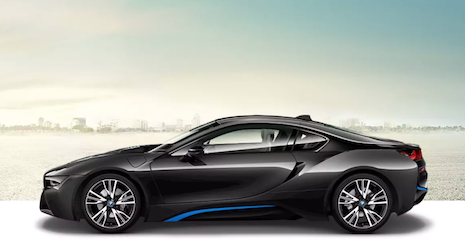
BMW's i series is a plug-in hybrid model. Image credit: BMW
Since 2017’s start, German automaker BMW Group has sold more than 50,000 electric vehicles. The number of sales of these electric vehicles increased by 74.8 percent, compared to the same period in 2016 (see story).
The energy-efficiency and sustainability of electric power has also been harnessed for homes.
U.S. automaker Tesla, a pioneer in the electric vehicle space, repurposed its automotive innovations for that of private residences through its Powerwall home battery, which generates electricity from solar panels (see story).
Tesla’s Powerwall captures the power of the sun, day and night
Earlier this year, Tesla furthered its energy efficiency mission by installing its batteries into California’s power grid. Tesla’s battery facility was inspired by a Southern California Edison accident that sent thousands of tons of methane gas into the atmosphere (see story).
Employee advocacy and the role of education
The execution of environmental protection programs and policies is now readily incorporated into luxury brands’ communications, but employee support and awareness remains key to sharing a company’s broader ethos.
At most, strategic sustainability should be focused, starting from a brand’s interior, before radiating outward toward consumers. For sustainability practices to work, brand employees must stand behind the company’s efforts.
Employees are the best brand advocates available and can attest to a brand’s CSR initiatives and values as being authentic. This is why so many CSR pledges rest on education and empowerment to build a sustainable future.
To bring its future vision to fruition, Yoox Net-A-Porter Group, for example, plans to lead by example by sharing its knowledge and making innovative headways in the luxury retail sector.
Yoox Net-A-Porter’s sustainability pledge lies on three pillars: education, empowering women and responsibility (see story).
Both LVMH and Kering have fostered relationships with educational institutions such as the London College of Fashion and Central Saint Martins, for sustainability-focused programs.
Doing so educates future luxury brand employees and creative talents on the necessity of responsible design and manufacturing.
Kering has taken its educational involvement a step further, developing the E P&L mobile application for Parsons School of Design students enrolled a curriculum of the same name where fashion’s environmental impact is taught.

Kering's E P&L mobile application
During the curriculum, students learn Kering’s E P&L methodology, which measures and monetizes the conglomerate’s environmental impacts across its entire supply chain (see story).
Stalwarts of sustainability
Across the luxury landscape brands have been increasingly transparent regarding employee benefits (see story), manufacturing processes and other CSR touch points to demonstrate the industry's pioneering nature.
But why start with luxury brands? While plenty of mass fashion brands have CSR programs, it is luxury brands that dictate trends.
By starting from the top, even if the market share is small, there is more of a likelihood of luxury brands investing in CSR and sustainable innovations that can lead to a mainstream embrace by consumers.
“There is no one driving fact, there are many,"Positive Luxury’s Ms. Verde Nieto said. "The younger generation is pushing for more socially responsible brands. The media is talking about the sustainability agenda and, of course, technology is an enabler.
“Younger influencers have started to embody these positive values – they don’t just talk about it, they are it,” she said. “All those factors are combining to make the change.”
5 tips for CSR authenticity and responsible business practices
- Diana Verde Nieto, CEO, Positive Luxury
- “Leadership. Sustainability ought to be part of the CEO’s agenda, and it must encompass all areas of responsible business practice – over and above supply chain.
- “Consistency. Responsible practices need to be embedded into the business, must be cross functional, and also rolled out globally.
- “Transparency. Luxury brands have to accelerate the conversation with consumers surrounding their responsible business practices. In the near future, companies that are reticent in communicating will be punished the consumer.”
- Andrew Winston, strategy consultant and author of The Big Pivot and Green to Gold
- “Authentic is the right word. But relevant is another. Meaning, the critical thing is to understand the real impacts of your business and products. What are the important environmental and social issues in your operations and supply chain? Then address those. So, start with good data and analysis on the footprint of the products, Understand your suppliers and their impacts and, third, be honest about what you know and don't know. Communities, consumers and NGOs expect action, not perfection. Transparency is important, and it's OK to show that some areas are works in progress.”
- Yana Bushmeleva, chief operating officer, Fashionbi
- “The first question that the company should ask is 'Why do we want to incorporate CSR into the business?' Do we really want to build a sustainable company for a better future, or we need to do it to satisfy the stakeholders' interests?’ The answer to this simple question will already give a direction. Of course, it's impossible to do an immediate turn on a 360-degree, but step by step any business from any market segment can become more sustainable. Focus on the particular sphere/department/production phase of the business, define the goals and KPIs which will help to monitor the implementation of the plan. Make sure that all the participants of the process received a proper education and instructions, otherwise the sustainability efforts will be only on paper of the top management.”
{"ct":"l71VAeAHWCtlze0cfV6wk4HMM0qdK1TZDowKpJI3BQI8aG3bGsoj3RN5fb43U+4FJOWxf4FRZPv9RHKHujmrQ7TDZ3TYuaaSSRiG6n2kOp0AQ0dGKceQa7WYvCbLFfylwCw9ADVgVC8U8g49rf+QT8ms+17PKoqMcPG8cnUei24aM2b+iYLSfGhMQB5aFGzpCz\/iMHWtBNv21HUUuplfP5sMPpg72z4PMfecMAwDErd7pgRyioR8biZlflHUgDy5aOUiIo+E7sX3GZvkyI73qeRc6xPwpkaxcE3rIQjLOiD3f9VXF6VT107t4CB8juV7jIemYsN+BYiM6CTa8O1YsR3vkKIeuQeNMzgOp0vP4qpz0Otf6lEPTn3nHTm6eDVknbQ4GRDyyosTzqoJxaqnW4+pif4OiKaza4ZqABtRoDvfRjuJO4B6Xfe72J2pxnYf9yefQ5iD7IVnOHHK7gLg6awgHLtxVGdcPRvaG4MUOEvzCRucnjA7jUBOqJpH6pz4rN1Tyx52EFXvoYjRnQQHMsh\/4fbZvYHkssNZGnl\/tXswFb5jv29JuPrJ0\/JNIb+yctEPJFJFw+33K\/baKuQ5LO9oRXFRK1iQG095bsd+gRj8FEW5AgP1VEsHIrucIoD18NFQJF+YNf\/nGmix5y6Wvik6YCO5YSwlW062Nzoax9TiPESVifXA5ggTyTqpFSX9QKv0Qb35y6XxzartdNmZZhR7jVsq19Tzc7z65pN9OS3VdL8QQ9ZkPPvzMIBKnlXSkSD3L++NjspCUCl3iaccPz7Tlkew7HB1g5kihD8Wm+l5OmbjYGkELyxItxZnkQd129P7BuyucXmWc\/\/NerFdUU+VLIZTS3s7BmyA6QPE36tXuTU\/hVetxGTHi3Bv088IECsXRzJASoH17udqbIb5BMV9WBRTxDFehGhcZa91blPfPo5QSxkSmVzIZk2XFY4fOUDDCT1165d9eVzwWH8u2zOgVo0wEQ91NumIv3b531Y\/j5lr6dnPZPu+PIYbftYtlG+vHfTe5I3cMj\/atNlkQFbXCd+RlqOu4KLpzefTk+55C5F8FWvCB99rVn\/F+vDMPh8L\/vPw8vD09yHXi+aHi+7M1LTDuSid\/LXMUKkM+ezA2VTiwbEXfdfZEfmijPQOYktYQ\/c\/jYlpLLey8M+D98PIhLuCH+UOO8Nqll+27m+rZ4FoWH7Zu53iSfQgoRCgr1cgGPtcuw2tbx6IL1W51LnSL9AKfbreUmAkTBpPk71OVgWi+e5+rSWxsL1z\/Dv0EXLPRIiKqZ8\/BHSt3YfijkrsbLkfnoTuVsheYrSvnsZoNa3Zr9IFpJnC0f6jdGhYGMR8eQSjBYwHJTzagLTUsihsQfrKWQJ9pElS6pGpFyM\/KYyDEFHZsuuv4nnFYPmqkkBaziy3V0rxC\/Lw31u5Y0gu0ZPFz0Ps8F+3rseHqmkpdPqhciFl3LSOOPamUoRrTCKui8bz3khLsQDMd00Qj4U8sS8UOgeMnknwNEjdeVHAqFmjKDW6dfblUR4dciXSFz9FdU5DGB\/OSsAaxuziSgdclVS+77VjpFKugwXOyKf6UkTVyCRTF7tP7QM0M+kt9LStJyqqr8YxqJKIKcT2NzEI3MuAvzxrgWZjPGgCYS2g40CU+ZTJLcV1j2d02DuNlYN3HElOezlnJIG5G53TX3k3jSiFWtZLv9yzo+Rx\/FbUHB0j2fXhyEDwckrMxmE9d+noOQCQcKI3oYZXa3EvL6RRCSCFfSfcIB\/naYIyTjhkbQc42MmIFNlu+PbLzUK70L8PCbLvz2bH3\/zKl1QJdjbCWqFTO\/E4SVR8X8pGfN3WsdTAORCbMfK4Bi0xz0wBZeJwyvA4RR2Xu7crijl7wOvdZrQiSQjqPzbDtoQUmaj8nO95Fm1w2AKWy9wxbWLa1rUz+\/7PYEVFct0n5WxubZV4ja3EeU2cDhoMASk3qkh5+isPU\/nLCmN7L5t0LfWkborwUFafHgsexghJSZhE8j6OAsF3fGRHWASvxP0RYWdf+L4CJBVC2aYamrzwabpT8WWftYS1b5Kw\/zYsvsCat5v5EngJgO8OVJSGWEHDJd\/OgFQ2MAZ7z7op5IRixaPfdgc5qpO+XlW0L0kkvlYf3jsxTQYP3NcAmRfBZh\/aiN2ePdXVD0rByvsvPA7LSIYAuXphIpvLo5\/WnzY0gyP5ACd5Q5uC92X2jKg\/SARuSK2WAfeTY4kxdAQTW9qbnJEfNkeysl+4\/knzapiMr6CnVdu\/W3MxEL74eWAOEPdAHB1XEY5yxTMEuea05MlWpO7sQ3qVkmin2EHKR1XGkc8UaMJDkgSsYCkE8dttpQ6\/RRNm2o9soCQJz2nLdAI9qOy+4yqJhEMuxZuqRzBDNl84azqnC8B0cmLjNAWCT2BiytIKMkh17P5whEp6Sa7f4f5Wh+NO+zqDflPhYDUofi2tgL8Dpkze8WB\/fkwLdTdviqxlxYNjZrEGDje0EHbm7tzIB0HhP36eYYg5kHXHY9MQjSP4vXBhoWwMaQHnEIEzODfj1lRDk6npYyUxzB6I+knQs5qyL+aWIpD5xXgcc\/8rr08GC8dyisM4H6VX8i8xmV8gODyquUOV8ecZQB2A43tqCwMu9qXzgYbHA7wFj3D4wKOcg\/aybYUNpzyrYZT5ZQKvwZDO+eepmeVAqJYUBVv6ZmRzOO2vgdQJOsvUy0yYU18tPLlSkt6HwIPgQMGVuVvNFlDZTiCh6yivimzRN3PO1PxJDcsJZAPc\/zkPUFqFx4vn5wTHFMNcz2fii4x0UUVHL9CQCuLgFpVz42xMXHvNE1c+DT+dCSxjJsE6G7HFB5dP+872\/6KXicJ0VZBtWZ23dmml1yW8xImEjhtR24WH7Dn2f+9kX1EsHi5Dffjgd6GW2EpoUhgUpVKRYfzAs92PcyEqQxMIRh\/hBRjF517\/3X2YSQrnODxdl9fYxoGmQQ9Vi8D380NlePCypc1YMMUSLG5hnhxdHX5EQyWF5yObs1arM3rJ1rU2PiG9V6y70me9Ikgu\/q5gvlHWVnm6kAS4Vs8d2HHiPRWfVLzU7zsEkXn64gedYOGY6GboDqg+4ry6M7UAf8c5RUGZ6lL2er3S055YdEnoe0LQ19wihjeu\/7lK3qQWzr5wnEufd5sRP1D+Kc8Zv58Z0icHwoAlaYVCv4HNqmJcE3gjSH6BP+0\/uYNMakQmUyq17GSmds4SSzV6b2p4n6Es5FRJCRSHmXbWRM20QHuZtLB9SUk4gBHZ4CJ8HMjdovlbJPIXqfmhhLFladOHY3ARHtVQOFcnH6Di3OhEy+yKHTWxxgWhMZpxOaTf86PtCpVzt9tZB6sfjUBMOgd1Dg6f1RTBLNRq\/y\/pQhlMcdM5r3LML8CCMmbLHTMd179mv\/8Ill0gh\/jxnibvJfBBNT\/FLVTH5o+6CCfIATwzYCOAK5y17kAvslkXly3IRAGu4eoC+enUQPJUNTY7VNChWrs\/nFE9uLmVEjktLHqLIVoc457YehjS78KFVK8nP3gBwsC4bCfEgMRRaZ2IrKNswsB10pBg2KgjUbygu4aTIMhhgYgxxlTDUJ+gLRAGyyBTT3Z+bsDnBS\/tWM\/VT47tjPEELb1\/VMajmcmbXcoilYN9aGODF424U3HHN7FmAvPosSSrDbK5+Kx8flqwfyN1\/eeXhNnf4McjuSJG6\/Wy7uWq4klEwjKFALGEuM9otzDSe0tf2O+ZfKHpIDLwIJ4rksUwxPRIeZJQ+bVRqvw4j5g2fLGW8AL91YRgwjObAgehBp0huXeEv7PU5RDipx1WQr\/4uhDE5m+D3WGbOAWJbGt3e2tPFHT\/hZaqHKcQcp8MuyO\/9cm5v+nz2BC+N4NT6MRpoybwZiQSTZDFLfg25BVsi3XXsnqSBYdcXi+heiYuZ9pM4TFcVji0lKYnAQ2tXSCShXDKSxdVYZFfbo5GTy7kEwqICYXuy8tDtxwrorRsKQdZmtp+4a\/FKhT+GwAP+26KM+mcU98pvRc\/9AsrrAsXKYW6673wgtppkiIA9TjFJfQxVOK3Y4tRDlMVHF1dpifHDzDG\/7a3qad\/47VsIwYZQ1TynrVfyP57II\/o3r6Nk6qhNOnak4A0SqUNU1+SHdgh2oWpFVMoz8EcgMBk0cPXHMv3WUNrhEw5B1GEPndoE0BySO0TbV2QtNANEcoOHiOv0vQ+ZSH\/hQ\/Oh7DtuIHZH9SKzQ40Vkm\/Ml1GXxul3KADtVDaFiIvWs\/4NO\/ozk6QzS87ZFZvu1yejJDzA0cs9jo1h90RmYehEtmIUznl9iKfQn3sg7+fSIfQtNnylPuuG7geEo\/o6c4fcZl5oFSPUIETBBEVWRG+XHHLmvpPdNkjboRgjgFvVRZJq9gZ+BBeKEjoP9QuvOu6AzXHf4GSmB48fZkeOxg+GnPZ5ctMXG+k\/\/fjEqp\/maMoe+POVYXJtW44KHLs6Jd3eRbxCa7zYZJSF6V6y5H48KodNshDiUBoAvKy5CDcctEox+ecx6+zTjo+kzaJ46ZJbKWojnjYaeF48I8e0jSpCfiCHYJMpm0e+bptyQotXgNHOSFPLZ3GQsOzrSJxkSA8OS12BGw8r0DvdqvY3AMXsXujt8qs4zgXe71+2TOPblyY9rgxl4YeTK\/0f\/IyQcP5IuYX7kue0\/tXrJ7UBN9730axmttc4irQiSOqpF78\/Fm5Eqyn1+Rom78Qr50N6KCUgIJg\/Uq1OuwD1wFwjYgEwRRaV2fde9D9t\/vCcnntoJoWLRLw4dvamTNqwlIZGHHhUPygUafgnoS87zLD+5hTNPgnrKYmOT6+KkFEdJOjJpoa8Ek0UePA\/kuUSRmv9leEDMj32JGDTX2K6tCXbtpn55FCUFFpSEJcwrxBXwjoXOfUDgvcY8PTivXhJh1EbOuEetamuLKN+QnhDWctAUhXhTVVrMnvfGeBfnov1B2jZijxKaXP7N8v+4fAQGtPNdz9c1LtMdwF9zP2wFnQ73QnSuD7vnq54kbykceqePoQI0u5Mh1X+V4qR\/\/I\/IWxe\/zXEzkmpi77rgY94riy83JMqktSPt3RoEOGtszerdNVCVQ8daLX5wQseJOOoK+FDDH4V6\/5H4mE4JEdUqpP578S4thg77RjspaIWqtFNl6nqZXJoczELyr5uRgQKO\/QGSP70sucnYfNFD\/LCafE5DK9tbaYfPtAAY0VwQkJ3+\/8\/JlEbuNSuJSR5kfzohVb\/sX8T07MxQCYNNDaQr++MLQxdL9S7S84BgYximzRo6ItQfnHJ7w36RikZkJM\/LALYZQZlBVd9\/wI3z3UT05u6INeOOcwNwEq\/W69G8DJQevi1lXvvxkKZxuNwyGm1roOHCX\/lWQUJfojAoN5itdObA2DJdAqWYEAv1wfwRM4YjrX5QXqsz20bdaMvEYH8W3XfAi5oaqKr1G6fQLqDLMi\/bMhQmUMQvR4wBCpqsxf0DtnDsyAYujeMJNfKnqB9QVRGwGXHHFMrSJc+dP4hsLbrsSH461zj9LVLqEGTT8rFxpGJJWFjh3rj1Eoi5GprWh+gnIoHL0Fhe+1rfasL0+Qruh9VVrQ+AINW+oa0WtWKtWZARjygWGZ7FXYAmVSmUWv60FJopn56XxpyFQ2jq1B0f1QriBmS8SavXBGX+H5OTbb6m+reGzazPWSszqDz2L+Bs+J7KhjiNbR\/t2iWhkDyx0H5dM0L+JQYD6ayNkyEdRIvkCpQgjzC3ckVQwSIDv4wTGgJGji2XlLVS0Ku1KU5px0St96eDa4RNghDQZk6PWwhKewJQG89pBbSAuy1FsmO2UkSFVf8agAlliBBf2lF+nkjBaghIcqpZalph62rN44supKReqWiuEWrpRqIShTI76eHmD2vS9VQ16xHSLMnw+GM8aJuKIzh3PvNohXP8hXhE53yjaTf3MyxJlbA6IkK7fIvHAULWMXj8SAkrHz4lqJ2IuksAJdEk3Vhlw95bFpkQpqvXJkQ44msZffGMhtEQP6\/lFqt4gXBUEwi8eV8ITnd74YVVbAf8r0IZM4Gt\/V662eLjy2xgwSbwF2IBuNLqQ7XOkmncvArmEerrodcIWvwSGkBRKz5zf4JSmrbYop8zBiBMB3G\/3BkS3KOLMUJkroA\/WRicrANBLXF2uaaMrJ9focQQJog5+7yvIF1CMsQQglUXr61ZTGIXPne97\/KZHOkep5nf5oY\/36bNkgvazKzo9H91hKE44XHqlRicaflg6B6VRUu+W7CckJtugVd6nqWV29OwT2Xm8whXnAJWnql6t5w+rbbI8kUmAHpL9Gnm7sCaK2\/FmHkfobb9NG12BBh+\/bnBOO7dPIudhwy8tME4p6fmZwA6qzQVazJ5+HaustEs6S20e+S5TYzurFerGxEYEmCX+Pgz2xb1KXiBfKoC2ZacITGrTZe3ACQQupvCv9xpkCqO9zJ6LS9EjFKPhYdaYOdbQvyL3TyICS8EUmzWJcX5rkSlKw9yzTErWcUO4woyYk74JVYUpW8C6+O1d32CM1MUM\/ZC4t0xwGSnanfuADL\/t+8heX9z37OL3nDrJpTuNjS52obvfqfwPKUBIMlT1MEHNnpy\/d915VwZKUG70650zw\/UHd\/z5YpKUoySoGwk\/E3J3LVP01WUDq4oPxUB7LJH1S8qxfwIfQHIYJ\/xXWWTOlVzSroef5232p+EwdM2tIxHVcZ7hUBZvcxsdclIDdd48AdAdfjEHQOfKOTAWlZ290mBrR5yFS9xTlot+QKkrzWWSmHzcD72s8ZwR46TTMsyN4f6uujzbXZVR07tVqv436z1uE4blcURwh08UxGnsUL\/529XxS1s4Ta57OIDtmvyJ3Su1EhJ4SaPsLLEFbZbU9up6Y9uw6pCAj4ce23GscHH37OrShnl2NLD2lcMMLW9zPLRpc0uX65t4F4Q0PNYTnDpuQOTFv2b\/0hePGZ3wQUJEp5HbI3qaTLk\/Wc1D+ujmz3AU\/SFHZFZZ+RP\/lAouExLve8t2vzYLgY\/DCf2\/Mvxigp4YGbyLUKh2apKi1yguX00FAdkwJhLiPL0EFx6+t6zOP42ICeCyYYwQ1AVTSZ7kl0rXnCDtziZkEmOZbXy88XEuvzVNxtxKt4VA52yqJV5vbM32CMf0k7YoAZK7eORBnwTRsGrmMzCxZmXSNFBh02oyrSXeM9Lp+1BBRBh8P6uUZ5XCknucYk0dHz51vqYUvpi+M4i602OuRHZYv777JXvQ8TMFkZGTYRoDgQg8uJ5Z4Fy4Lpp85vkEYmr7srslTLxU27dTE+vnA91mD5tzNPmOeQf1yWLtRCBNBeApvFKn73GNlCCm6zSkYtrPKl\/cyq6x8EU2Ey1nzT8kHmzmtGcfA+fv3jNmYuX0dtV79mBqw\/AIub+MxGT\/CJN3dHlawUcs0niOlfL2esWPc+Z2MBkM4UF\/MFIl3X7rH7Kqb05k2cBzHnoD96oUH26LymPiopvw2tnKOGBG794CerEH821fRe28IuiKZe5t2IrDvEag84V1j3d2dOH5iiT4xrePmLzzbhbJJ9swBnYc6169ZtAWd\/264pjDRB6lrfenn27DKUCECE84t84YhmBdYTST3fEDyuk5PQVQmuVCfxPtpbdFz8utE6LqBSKvbMM1I4RKort1ojQmyjk\/yca\/Uk1fsjb3qw9JwilHIqUOUHh7rWN5+ZHRiJinFVcazo2hCIYDfeONa9kqbkSq8VXosvxkyGlPrX8FMTVNMBfqTxBUbdO2OkpO6uh7uSpLW6DoPCNzfLtFPvK8BX81+LXoepJ8DjEzLuAatsv7vNg68uQ84RneTHgYZ8WTYoQnTlByKE88N3O7BMSqJeXszKEDGXZMPd56rKB8vek1rofxmZ7e1646PwcL8\/XXZA0tIG2UPxp9Cpwx3aEzEVQkHmK4kgt2l4fCn29HFNggIQ6g13SGVgb0po7EMqmJUZpR2HaQWXW5o\/fsF9\/rcvUsIZq+DtLTAtT5G9vy5pCqP9Hw6zTl0c6Qx\/6Pjh0sQpjo2Sd+9XViMs5OjxztWbjMweMkRrNZOn684dOx+p6dtVxNsUJ3mubljGTCMjdur5QlXng83Hk0m1p\/Aa6iSwx0q3WTfltoa\/\/I+dAG9YrGal5gneH8hwoxfVOfFz\/zfRIHgrKsh0DkEZ7ydg6cTstSu53D0ZHh9NvVz4CZBdKZgOl5qz1Sjzly4sqnN6ZfEAzKxsW4I7iRhOqqNobO1fen\/8AdaPtPO7inwWXbq9NDT\/8T27srCRsQrRwLzaUmyKzN8E9EYF\/oxBuB4A4TJjEtqGoazGJmm\/XPM2ePFMn3n\/On8yjGYP\/NeEn7MBxNE5cwB0tvLNpz36expTA09vbQyZzq5QgtIOZu11HLJA0CSbMJwGzFf9UP37A+t95dnrr\/T1h\/j8rfvD4rTFyxUPMwAzdfS9Aw+sWVtg4cL\/hL4+vtKZAqbmNeAzg0NsrYbaY2112pcJjwdUToutFjCJMp6YyP1oh43fpqsuX\/zggk1EyAoeOJYj+yl6xQgLn8Johf3UUjHpzqO4EtgrgdersNk6ApuZXx7MLmGmpkzwNmbfwxgZStUDK191kRNvScMfXUH+o7Y0X7M6x+lJtu+SO\/RinqLtCNbROyzejwbgShc26fJhaw7IOY38uWsIBTbZszQjAN3V2LfmV1Fp0aI9ee+Lq8CHA5RCYW7uoFQClq+mLuIEz5N33RqfrBAHPfwle4gviP\/wsRDv\/+Gchj5b+24qUB+Hu+RyzWPXYlTTkwF1TGtPR1\/+CfWV5A9bhg3ALOBhVQ+uNdxNeWLPL9VUJqtr5qOfb0njshSnmOsRSw674Su7\/yA0tgwtI4+zqvBM0doiw8tOWQqsrB\/faYUY7vgADROtqWxqA6wmDoT3PTBmF5dpByN9Ckh1Oz4tX9Z70AJoAfFLg6uub7OovR6PhF8mVVyVNJZvdln7t6JyuX5283kCwFyQikwbtCtkWwmQ4lsz1tz2dp\/C6IGBjvdnwm7WkAUo5ixW\/5slLqJPP8g0M2cBExMK+sve3PVx5s7WvLDTPm4RAAtI2BSYPLsdMvxisQuHueT5i1SxFOMrvAHkYS0DZAK9mDOzzPofNXzZ5Ftq1skapVZJI1DffYqR6Vtch4WDCe29e+cAdg\/I1Lg4HXh0n73YWHEs\/\/W9tlWQSXYFiPXDbCcUAJxSrKjumETna7Lb4KTRUscFOQHjCDCv01H893WiqzXcV+nMqwVmPRqU0e8RyD7zOgkDRdL2csN0p4GCCtluY\/49UXhNainiY\/lMdlDSxNV0I4i3FD2PscecljdnGYK9gxDG28BKQxuav2UzpnqYggbhPluJoApyK5A4vMVmXFzFE40ux9DWkpCJxXfiCXcB63wTyWIbuZi\/QxOBI08u101Ow9ocb6OcHP3BRX6VCCyZmveg4HkntFWegBCp2RVVbjmmV6+JN\/78uVUowEqUp42Pm2pkofP4ZiHFpEZEPtyzZ8zC5j3lzxDhMv5JQCZSyxu8KIkKcPHWbN1SbIGlEvdCIw7Ec25PUUSkSqTHnlhSfmb3+TCa7mRRGJS2k8h4Drt5puxNuNI5nIaIYHZZ3kjezcdztnjZ+eASXu2VCqoo6NF6AR4lL0680Q1qBI+O\/KHS+Prp207u5c+7eF73LC4hKhXUNTVQtEyVziVmvohGUDUNi37cX4bicxS3S7SoJmAL00ahuJmnGz0oS\/BBnD1WNWnkBxwtt7EgMEIcZWrUm10x6XYjt6PiKSAYaUzHe5RRZbKHBMJKbT4a4j2uguGp6REP9J0rv05lSfDvZe+1FOngWFTFRFcwZj4649ZLueynQipFxezkwIbjG32MzLBliD2Nlr4xJLSY8tpxyi2VVf8CdiQErUE1Ydr6C2+mYfmiVbjRt+UcCnMQw59LwzxyEAaszYhlh2PQd4nKz8PQQToTcz1G2nDS0YAD9Bkt7qISeAuXE8LOO2j8CTXSeGS75+at65QjfqL9Ok83Zq7HQJ2EeYyuTrFIpaQtl1ihVi775ABtXkLNv5dA+XLzFibHXXUE7iPqFUn19tF7tz+APEvcC0mc8l+N5EHTQmObFhWZyyyp5cmgWBGWvKkH\/ycprMY5C5pBc8ZzJ5Ch5+SZo2myGeWGjOm8HVg+j4OhE3Z\/\/vkybfL0rkcGU2HOoitDVmgdcpJeC2ROOV6r7t1nTS5i4TppuUanH0lGH4Fol4q6yWbBcLyA\/D4\/1Hu4yIDlWJCHbM7kWGp66FsMWGRmAXUyy9BPm0vP5ziWy+8vhEUGm6bT+r\/73Mhpq+oJqGNX8fDmLlbg6ifkOPJk7+iZGlDdPvsGYtLyHkRShxRcr4+tEtYYYUKXC6KcWGmfy7f+TcwC0yFVcZ\/WvwNlbNrvkQdO\/eM16+DV\/hdgAfDq55EF7jfLnxmmGSQ54cLPg2j6\/rnumw3umUZT3oMFLHc7TLo4HGojcQaFAuUjJFYL1JNgCoNQHYDq3DVnVPo5z5kazx\/GZ4pSAhU2U3GgSlU8Z3obGPGLOKoK18+gNjO1Rv15ALvKLK+DyZmQUo8sKSLd\/\/fGmRxQ1A4DE6iAdVDS1h2yw6lxlY1yGM4yp6C8jUUCDPObPS4mmL\/wIPC0OUAqPvk5pAo3BzNRnvCnYUKfipZCaZ2IUiGti9IBuqTWmjWkGF77qLEG5GzRusAWkFMhJ15YTomw7AbBGwrlx3bLf3CHPo9EqYMcieLrAuazpnQGCwbtFRdWJsQd6ZKRIdyCsYyArSEghSrs0uOHng7ADvNh4u916zzbz5y6yAJzofldrWIx4gwVCC\/eTzmswenoXF+W5sXuZrVnMibKGRiMReKNkxJP+gsie3FDpPvh7kKnJ8lk9pMFmOreTP+MQJUxZn+aycyBWcBjPjbkuJ2RGyHZNmlwuK4VsK8uACCFV+LvqqTWw+QaO3YXKmTxC\/21n93gNM3vKzHTfcZPHWkHrMj5gn8UAZ2HGBQvRIKuEkWcE\/0ZUSsLLf\/PQ+gpIthTSascpBiSh+X9JM9y+ErAcZl4MoKArSULCCdtcoy\/DtjDDSjckXx\/lDn9GZE4uMYm+53epRwwj7hvrBuaJRYSvG\/nYDqHVWMAWnE5NAJh7mwxvz1hiHC9dFEctoSZZGT4RyXCLSJFo2h\/wYfHvHYEg5fvb6UrTq0F4KlvYSLftkTPY9L9LBJJDLcXGNHTtAkvV\/lXJwRMKyZX1S0NLuxL3GAsM60jUCuyQPsUYxwaP88D\/XdARA+OIp2OL1afbY8oQdHb7cuN01+b6Fij4ADOpI31QemK4lFnp0\/z4if+8V05zH1j2zEURxKITOA2ve5NO6X2b9hR8Mg+sEfNbU1+lkh2xLXVtOIIB5UeSym\/d61rUmkW7+F3Lfej+oqmdmw0InQ3cNn2gmuPWCUyQBHtWOiZbL6a9TPMY2q\/99Niia8MNb2uFuODPPcg6Ae1ZMgapI\/QnIwebfOSZ5lEmHAKLfHJSRjCJiFjUnqM17qI8VOD97Eq2zX01j5enHHVORm+gnr+MKmaTkJ0Z0yOJRKJy98bfGsrmWNN4XZVY3MO\/1y09p7917b8PAXfQcdmP5uuoji5f726+gtpPYHPO6BqKV7p+2CzPFkW85qgloetR49yEhbj4H\/M9nGeCG2gheeQcYLl0TYJtcpGXM9m0LI7xgxTJrL0IRuFFoLcJZZ0s7XCiZhF4n9x8XveajsRDMirILpcAVL5zB3SGJ9JTndZ6pJzvt4RTn4SEL7iscq05aQGvXP38Yqko18olZsRuDWMKYYGgik4bk86WXQueykP5chPFyvA1mMerJCVlcPbTBYk+po1MzBE1M4KPVbhuaw++3wdokR5fv4JpFWlUb+5OaB2M2TBlxd7c3We5c9grcmgDYx4SVfqHvwy\/TC8yc23qrjGGI+bFjivHgkHGn1wTK\/FrE9j2Z1Q6qsXGiJI+pZQrbUcWlbMnb3QZuV6Qr09YWW9kktKE7xYVkNSo491BInW0z4hRgjfnq4iuYp0mLkutylKKdNE4pQYFdZfcNExTTS\/PPRfWSrUa+f6zz5cupSMukHWF6HaUoI+5QD1Xa\/2FmoTYc6nTJHywBDiOUIe9B7gk9eFZQtVfs4BgR\/AyTuhImqOz0ivchgZl3Zajwif3Pd4PgZxU2U4PL7bJQ9pQkCEMC4sBJdAxd9hl4TZ19QrIjQzEJYOKEzWh\/GrOhVtQdn3lxPhGVaLrFEJIEUuBq0+UOJCajnPd7Wole9B0CUhYWFEsJ\/Wks6axumGgQsn9OsgQXJiqPA0ZjusI8ZzRLKN99H6fA3RVyXzV0XD9grWsWTpk9gwbIOsNa5ihQbwhguszw39JPIJo37sAxaKdlVZe6\/YwqKXgpbAdATldS7TJBZnPEpidrFx6lGwkNzYr1JtBeLWM7QOUD0+dpAyVPrnJL1qZ8EHW+nD0XjZ\/FJhd3GbJ0j3osUt971l2xx1u+\/sIsHlEuurFbso9qVX0yEhqp57u6z1l1FLCajhDiQZhFT7P2xTHl4Ki0gDC1TQf2p1IPJsDJrGKYj4QybZStDRm80JtGuJ1GpvGE79ZZFR+pWlxFeR3Le0U45spG0ciF20oPgfW\/uWQgWBBw9yDh3SsM8zkzSMlixltgu8Zo7iUNUo\/zOOx48bOqsz2AC4e+vHRsv2pshfjUXqm+uyCtkJ9sIVWfkB8Tjzc3x0pYYxT8aux992B\/ANIS\/TCHAort3B50pRyfpKjfyILduBW7KosHtnC+QttjHKJLnNjQOfgvRJAx0CZuLPXHKjJkc5hltTPgFsTVeWnELRbbmePVxT4yUSXXtz11Hdn6VAx2TSiaxn+vhJklHbC5yKCAeOWmXBkTEvDDS1Hpw2ZVikYQPF1nJ0ZCUxVc3fY\/zcbyN9dchB3u3IAHcpuGrTd8DtOOcA6BSlI6Y63HMsJQ4dLa1YKVlYjBIoMJS2m98SOveD61NfO2WI0GKPLUY\/V52KHvb40m3VKJYr6dYX9KVywH8bl9R6GyVAX5xh4u3TrjN6TMJ1B74r\/2vjlQbxPlwHgyW60bu2BAybU71L9vV6QFJoZNm6UFJiEsiwM2fRxt1+kPmK5hfP4HF+pDPUIGvcMIGkpOG6qQZ0aTFEFG9DGHxfiTw9CI8wVVtX9AR\/cfcWOmgqlaxqmo0X8Tzl3vq7sXw\/MM5ievXHTuY3u1kxxizqfAOYq0hC7OlSSS9lu\/OLYhoSq8wLcvpqGHQOA8npCCnlUCS7c9NBlnwEIR+TD\/UpzvKc2uiXBr0Ee4URljMS7vL0A1zOZWE6IWM+RN3UvzFClqDts3BhJRJoqibY4QJ\/7xinmTsaT0e0EqQp5sLkKni2F85J1dri9VkMAGglvSnGxfaSgmnwBvOPJzcwXUUrQGWbKjCU8mbh+Wdnx9mn36q7XfreYEMRJ1yLNJRLg\/84YMEFcX\/PxAG4wPWcOlh\/PUgrpMuKWzAkHVSwiFCIhE+BtwCTXzIos9BEz1U2Re4yyH0\/NvmNw5ScPQRs8cexzKH1qXUwysnnnicpgD5ntU+NHl62vkSTb4+yn49KufB1SI7hi71Kfj0dbznv3MvxfPOVUW7Ky\/kq\/hc2zGie444bw9VGC88vBtEbwMyG5iEZg72XmCLkdH36xcUjclKaJRiAAf4sydCnut1URCB9Mvdr0td0nQGE9GJLKldjUsx+SoMUpPmmWbrjR3026h0KRUala8klyXtsCGgCwAPnjh9SHfDpFb3HIthQnJGW5H6o5mtyv4dBnHZwXQcuYGvC9yNmrQSeKHE6yuRW2FGXLEozzoA4jvnkWFMSM7tr0ZX1EiPotYuZneVfLstZelS4LcTGREJVZor6K0OXlvVfcHuXoRxY9ODikqp\/IZntE82Knu3krJuQp5yf9S02C3tt58FVvv2rmR3Ktl3b7iUQJTHP44bkAphi8wm\/89Ze9lHXxv5SRKMM2LX30wfv6pM\/q3kbqJRGmv0mejZEOd84kSRJnhQ6NRsapGkCmQqqBvUibeqCfWn2or9mUf4CuPtZIYmn8hHOQ48rnAE2BbLXMeqeLEZoY8+BmMC8FTp8oTR\/7Fr9qzOleCe\/egBK9RxSvsV32do2Od5ZuEzwnxIP+YcjqyXhRpIA38bMu+2ZhJfZWFjYJvMs4a3M\/Gy44iWLAnm1iOAME\/i\/ujebokg78IhyjRHyRscggE2x4CZYy1YeE0gLHQPOi3IcxG82SIsaOyKxx\/h0UZHIiGVCRd\/ru\/Hc1XgCddKqZeF0AeMAFit396y5NXxPvakxS+BDAp3UWwmMB8nqejA+l4+Gz8LPrvX9Cs7PSwMv+ifYsMmTxjhVUqQGmNmN3yYGIrhEBc+ZDa36Q+FeDXaZFQDsM4s9NSsogZPWcuHdZinMgCh4\/LKC04+ACLUyuWrp82DpMuzBkL1QriltDalozvxVYsXgzYrt9UFoJ7ZGiHu54YifATsguxknx7GDfCJzn6K35Qpzqq49l7sbYjebaftECd8mJ\/ZTChIe6cyNFwTnVhWijrbnA3OVk\/KiMKLV9c\/TcZgSbDCjvfUyVnwxK+8HmZoioJrdxyChUE2r7pt+p+nlx0iOcoLhVTmTSVmqslG0W6n6iIX7bSH5HhiQcjqXBcniEWo67\/ITfpfpFs1JHxKbwkPPR1ePwY8BvCiZJ\/kShfpMlGOmwIQaapHa9vR2pOENxrVJ7oY\/lRzcIXp2286NtVCx8VE\/bPRdMaNPd1wRTq\/xN3JxK0+oAhJ+\/oOsynwbU7SSUaKe9NkcBoOuqHJ2fFKO5CKWOG\/SltDMytZdblbVrR7aclMGg3VZwpWSU74hMXP+5Aopo02T3jsgDZe8r78YHsDvuji4HNc68+oqSjYVEmniSONcLY5cat0urbsIwmqFzFHWE5aMBEg7dJMyMlnxNwrsr65+EPmZV7y+iLpdpG+66Kkmsmfd7rvP830641m537ifECbeuWNfeAHZZYiJKlphr6C2dS\/SLIoRfCY7LNeeXjCjdawcCe2mAX6cypAFJHuek8WeP1DOwcHmjy5\/3qoCgqHrSaXyuSHn01Im+8sTY2mNsWkSXToKSPqMjCEgt+D+X1AK7Ce2sKY3JgZ+jJ4RkZEsWIi2crvAjnti0CtA+uOwovnWfK7YKE2MgzCI2q42zIWC7A\/W0U419M\/q65hLpHXStvoCnR016CMzryRhPlWRUkQ3gGPbSQVRtFlNhqJm3wkKiFAqsq7hFx6gH5T6Bwt\/ZSQRuoQu8d+6XyV51089uOYJbRD28Go2iYMA4eVRNMie1eF\/nboySrkTf+pxzZ4Q8taAXvKoW1o0EZVgCbMdzIj\/YFwryq6yReTs5wkNA5Ys7NZLd29nTGh728B2gWox1nl2hB5VBbymNwyQU+bhHazVWSSk+Gc7rJ8B6m1iWY66aN6o7OM+odjVNApfOhk4byTcRNKBon70dpw+mqXwNWi0LVjv+sWQ8pMRGmesqTmQ0Ly6OWnMQJm1NFoVlzHnkAB7du+SIrqIoUhVGWvhwIhQv4xyKF6ElceOy2\/7VNnkkiRK9obtkOcUGFlHABSXhmw9WZkvEh\/QqKlgM1TuaZ4G6DlCebC+GMt\/XnoJH\/LQcMKMBL1vY8gNT2f9bvosoL2ya3Xo195ibAndqkr57qkbQll9BNX\/jSLBXAyt8xpcKSQepDOuCMznHs4oYRWPocdnjEfTVJCZrJ6JTDSfXbnr3SIumQ31taN\/Vkk9hpF44rF2yDBORsvJck9hSjum0LFFyDtmptpeP\/XaVkjnrzB1OzGd4decT\/b7j5aKOrcdNPaNDgsT3YR84IXM6pQMqz0CNsshqFS76A1iUapOwA9Xsxp8RmNJCLPeCKwyDHx0mfo+eU82BEZyRaxcdvqlJ6LjwsI+\/HT6mo0tUHsajQgZSbGjHmUlnQPVxWJAz8zDdcKY3IVIEkNJPFzuJXMI7VuNaknvNhMgBX+OkGQ3F+XUCqbF1EWgWrKNQEfZBqqq8w17im+p5\/dHhDxatTr\/F0n0DhrE41QSdwB2eRZqgqiXAzJI8r7v1LqzUvJY4FGEiI8ADa\/nOvbOOiaCXaYAxrHhaEuSLMD4I\/9i+CyDE0PigLluSzmfPUZc5RHqG9ukhoDTi9+Xax94I4c9KF3GSDVsJND1UiFhSPGSo1PiSo48qjB4zyoZfM0967i8anFu0DtmtmThJIKMnJXGvG5FBSCiwf0jEGA2uMPkKdcyvRq5HC2FhLc42ipyUNrO+HFlw6qkPTqTpHiq37zuiXvL4aM1CmU46yM4XJKWcuo0sJd9ileSlQ4qgCb1+jZYzPVCzUKWDMgsvqByFgsnUo9JWwNKqjxw+naeDyuMcC1Hxw4vk8l9PsSunwgpsK7OefAgKo9S8L86XRHCmNCwHumghOJN9vlYgkbiSOwxbQEK8xl4dEKnIC2XfAGmKN5j9xqD1xDrb+fzuY7HgRks48xd+Fj6nLVvkq4Q3GxDT\/Cpfa7oyumP0TveWlPmbrEqLOAiBoszeBFsfH5H7ajdPFP4yjhkEXyQ3Ev5cVHBNt3q5qmRr1ylGRuDs7Z7QFNjuvlzBo\/HghmHGC00mha6EcXEH8S\/vTjoruNg1JWdxKO7KhLQ3inkxrzOcXO4kRmVLbO4OpKjfboFNsC+rBA7qYhSmyMmE1E2JEFkeJVravReo6Xme3Ym42M\/j\/yNcmBKEmqblcHMH71wByLEoA\/pvrRP1GcrjHOWeYD\/S56gc5as18GrFuqMgH2Avrsl0Ux0\/bYLKe1PtblSk6MmvkF7Nlga4urJVN5m2hTqiWzI9fdfz1yV1g0I4bDahgDW+osfQm+EaudmmS1Xk7lHGORZ3hx7n1km5Y9AR31c7p1Xwn1erGZzt5I7lYboxUkzPu7Z24jtbhPnJu9LV9ZD+t9SiD2Dj9\/vtn1RMgJCAPfcPJAUlDfRrERImjkvurEjgpYP0GVhhqtDksj\/qjDziMIigVh5RxJgSxJWVK1xbuNx+2NG0QFoTsDKGtvZL3g2hsJHY50T+2gqelRz2hR5u00qJCtxfduf7Jy02ZUyJzlI9Mg+me1NVZtYfWz+J8LT\/h8z0n8Q6v2C7N8kXh1HDPVHp6crTFTvDAU+KbLxEbdRchBZjHoyOxLzsrNOVKclKR2tRpA2VWnWNyZ4PXYMK5IXCGroSoyrNbLXTUGDw\/6FklbuLQJ6qfOUAvBBqXWP0XaEuQg+sNwq4vFUnLxQZq0r6PANnbyjC0af1dZ4WRNJk8LT+l5e7Y6qTx\/q4REl90BKzSGdQd4rRAY4JFz6GljK486Yb\/CL3DYSQ3kpWLNJwnS9qMUaJ7fh6W7TtzwpXYPi6uwQkI8wFSWn\/nNn2e8AbkTvPsgg3iah7gakjYP17PajLljqk5ntRTS2rdmS\/MYhtBP6c+ivK8pcvSJyRzLYmzUaCCn2FV7zi90N1IOtk0\/1FmqUJgeNHOJxHuj2eZTrj3NUs9WcdxEXDRuqtg\/\/6n++hjb1QXIpXSszo2Rrm3CP15RHNXv0lJYd9AgMEuMJZr+naKs3XSzJIHLpy2ZSWjdCaiMwlApvX5H2dMBU3BRKyN0X1+yDd+tJ\/W5o6pbby4PwUi9JNuPw8XiA8ENs\/1vjq5lStdyJpFeHleNTqmyOgpvEEQQr8Jii5d+ZsHhaE6QmJ4MIEshG0UDlMDpaBk9\/j\/oRic8eImzT0jLZuoh4L5QPAYuaoe1sRQi\/8TkGDW3SB+49re+GMCZrHucG\/Dqcg4t6OWsCswiWxavtR2RwQti2J2YQNaeX6fjZEDJ3lq4j9PEFlw49mt154AJLL3dVQNEzgBddV6iHDOP1t+NzEpX8Z1hDNETBLgp61dcIuWKIS9xDaVQqZ\/qLCmy9cO061mId6mplDdc8mQZb\/6OZB4zv2XqJhjgW4OoXPaX8fRc9v\/fa5btSLYLC3XjsjzGjHsDfz8dUXXd74ftIZavZ5fwZqR5yS3jsUl6A\/OsO6p58rsIEV9nIls7B\/FqVlM3W1d9J8LxqdNfHEcKb5ZiWBUY3WyHJht9ksZlY+aI5Wy4InLluV2yn\/mMqw\/je05HQx2yHfCimwnyivxaxXSlTotW76I627WTdeXO+WwDhrM42nck8tvyIZFgjuJo6Ph23iUtUAgIhL934k6Kk+7abqUFnrtj1QcmBYq9jzwi4A3888GqNO\/\/yBTT4dk0n1kELKj3Yb8betoKJQRYiaSrzgr3PxIwZuOhbCMxQ6ispCCYa5WmwSA2a1nzaui1ADbQYnXM4iA5VFXYUXJLTGCPLm8H5JJx4lqXabHotyrNye+RwPGN9nuL9qR91PtuK3p9JIe3\/HxI9tyuLQHea4xjCKq9yEaDmyzViyrJRxvALkeEC2lkceYB5xeNlOVBSxwgYp+W6lVCtuVa5dHQsWo4Ge2bipBoSymRQsH24l88tlxgey+hwVM5gX\/7bZA8rQ2\/8XUkJZ4D25R90r7TEG7W5V6Vja0iBqqTkgt8E9RCe+Fqf5rSP8iA2YCBVblj4BClksTYqEJLKVPoOgBoLbu0AVV1\/KCCsFccQjmen+AaA1GhwwB3KLCKZNeqvld9Ww9JhQVmEBnVThyAuz5h9\/wgQ\/wFl9JXoklMUXzPiiSgDJG2VSkArmWALOZtzcXfLmC1J7D+tgJUkJEwZzM68rBMWa16b+1vbcHGtb\/xsbaof2XLHhUVe1Ou0XWPTPPelyVT6YHTf3osAz0DDJ0L39txFwBGVvqkAuIaeVMcCyU+sZYNRRu9kJymqDu8WuX6KismJP1yVHY9cNA10yCyVT1PG+gmu1doG\/MF+Un5eo+1gXl5M2OQPEJpcKDjtnvxAOdVxZzYTwyymge8CB9DTrqTGJwBGxYjnKfWK2U9jKqPVn4ejJO7lVg85L5D5oGsamE2WkJHvXqcc7lbwKTd\/6gGaIRQbbIf4RrvSipFzgd67emiyEUjbhl0nG\/FFNib5XqwZYu5+JoGH\/P1xxkcsaecRrRLlo3cBTT8u0QWwCx7F60Gbq6jXD8ZMpta81tBOg\/OFAQc\/m5XGf4pMpX\/xXrGPIdfr27ab7l4FeWjwJCyEBm4C4\/55\/8qgE5cGGDL0aSaw2YMRQwcSsxGWv3DQhGuPROJTgnHnXu64GdL8qEAh5FYQCFhisA8dPMgGTnXuQwwivGLQb5PiOrzyZSjAoJw4qRe7zngjvY8oRmnRkqMstk4w92l25RAd2Rgx5SQucuG7AZF1QeMunNmEA\/D7OWq35qyc8Isu2xw3TIrhmw7SQbFgq3stIy\/Ewevy4FyG+UgHGPSKomP+qt9MhD8wQEVRl7AMYvyyAAdZBSsSSnNjYVpalRIqwgdKT9Q47hfl2RZ0H8Y2mXYSxWkrD0j2ZaHxj0MA0sxeXwMmIQrS\/1l8EiP1ecqxy\/VZjguMdevLV3eLf+6iegQn\/BcLsv3chi\/9nZ0e7bcNIlj7FMwKwnVoAa5MGDrHnDOieGr6ABnO\/TLcA\/W+qMc6c7UTYxe78DrTQnWLrWABMKtZEYhDbKAhX8usbIH5+eHgoP7jjgjOMphAVt9u+pUIvJDz0H\/0YwEY4Eo5\/dfhw3Bn\/y6O9dw0XH7TovZ5N549Sf7LxlWNPBMag7DbZuD0JSOUe0QXOnAEvXdeaIaaJgR1ljbR1E0nmIBt+r85z0QsISAY8fFRGZxyOSMla\/IoaDvbpswjg6qMY4o1dq4M9vRjdessurfc\/KQnpsIbJ97nYK9RzMpxYCPTaTtDCN+quvR25jlh9xlsjHoJBmEhlkWyFcZvyBf7OkkgW9IkPDCZDu71kX\/GU3ZV1nZX+OUBwc9DL0vi9dfcyYy4oX9x+RgNk\/pQTP6Srzj1ubIUoI7LTcAzF4FtOcv3TaOkkMgLUbrfKNAm\/+sbO2KktImfH3QF6vaZUkyyhMtHNxniCzLSTqBswQf1wObm6Yk6Axb+B\/sIil4nNBBFfPfAl82yDH5Z1whIjunyoON9XTxgCHl20zfuOaX38guzDkoXW1xJGsgZ0vzSeymkkDU+huh7lOclChD1+u2yGSYfSEhXRsuCiVABB3OpNO9FUjoZtQBdMLwvoibatfE3MEPkO3CGk8y7GA7p5+ZRN1qd63Dzs6dpjtdmaiko0Q0dNucrPyJzHasY9GXPbVug5noIwl833QYsuedYsJm07brcXWu1m1ULRHXFKCXjQzwo5AnMnaiKut480BrXa25hfjmvW\/w+dOjtsvTO0T5Y+2m+9lfJ7wS2gwgfr+DfhCWPwOKfZUpkTI8XY7LDC9qONySGeRmdPPiIJiHFGFmzf8u6jy6vumNoQqZxWyzVFjkvCRMb0JRvEQpXwr8HrUBLMfQfsrXgPiBMfYMRgaMuduAdM4kEoUwJzu+RyZ+HGEoygq6DaGg3KQgGQQCXFrx30MInsJwf+MxSAe9Ccb8g5x8wn\/qaaWa8V0vCS6vOH77tSr4TCAKhsaVZk5aB6JxOkzpOGQAPvPpfbWdmdIhg\/Ths1i8uOE20VvF2r1TIRA32flatcKh2rDKfiq2bh1vAY\/vS9L7LTPs5BL+kRZAoGQKlyICy\/Loej4l8TegsVOeldbyK\/SvJEavLxHh3W2B+3XTecetdm9CQ1EGj3s3Sy1s+kMMTwkfowdacpT1XDDYm08nDq0Fr0eCUPlOfbFEXxgpijKAkLEXgk1MtAM+GuKcuLf1jj9QZLxSsIQi1siRo1WIPbKrrNS0Y2w+dIuCGtxF8EOej9COBj3HDqUDZO1Sj54pdLrB3D6IVjRX7evbAwCy6R5gAOSgX1V6ZvO\/2HkVXFF6zefJhf0u+7YQa2337PEztA8wcuojrkEa2TsgqDCD7fS7OZF8So72RRQbFtuGVXK58MFXvOdqwhHgmDH2FZXr1+04OpmSnjlu+AdEhK4zKln5UPYIwLcjxKXg5ksKLmewKiA3gO2ApbWWHUUgJXvAXzE+WrV0nnF1oaP02fdEmECivjj2KfdPnUZYgJZfeX7jgxlB1qiBwOfhpUG+X4SNqRUmspu3YNOOrW306A+MZ354WEJ9FSy+lSb\/MzOOhboU2Wgtm6t4dl5sQwltt5zNV\/zCssZQR6ncuYc4RzYIuRKUHAlyIQFfeYu1poppnr1vcHZSCxfK3bOHeg0EiVe0pejim4dCYKezpBTdrzV\/QGiKZ42RH3CXu1IPzkGsMqRvZz9LYZu\/iERNDMk9dAZPH0jocYnI1oBtQqeSnj98HBsejR5nyjcLT7hW5+fAgtiZCyT3S\/eXSiu7WO7zbPT9uNEcA7o+gM1J47TbF3Ndpgc9HkpTrft8UFUdvXU2fJyyQzJDLKcv+khDWKOqSBdy4JsRy3myliA9pfpLWMjnkvflkUIjTJfkWF3jORZHuKQgRiHmVpoBB+7VeF4aE9QSM6H17t\/hoIK0aF9h2FAvDKpl2zEAuQDBAJxc33OEgb4DX5W3Dyk\/RjQTysKtotOGGYLYhN4sBuIFgDQZWXuUgrDp5HNzbUTrDs7FhSoJCl3WocePykwFnmRMFqXEg82h+Xj1vZB09dS22dOGAdVruH+A4L0J88JCOoZe7LzgK1F9aidKL44ipVyetA+idyCkKdGwVpEAsA+e09zlS\/HPJ9M1M3dN224DdgUItqdFemwl\/mZ4SbonHpQBJQlhdCsMhltHEhU9LslXpmCkyW4vxnGjB2Qs4IlgeKZFqOL4h+TVKl+WU9dDDA9EBY0Ov4Oa4U7YyYEA8nbj2kF5f8zXPj1Sydgs\/sHnYTzjDvFNV9PKXi8yWeqVHjULnUQi1EwjA74IY+QoOYhyoW9eHfC2\/nOhDSQem0flF0ZCBX0sUbhLMl5RHho3\/KHebaGaIWhaje4LePjYJtwcFTlQUcw6ldFiUhW12zpiageAOXpPJrmW348uK2qo9V1e4NAq9T0w5p3XDBjEfxshZwb1vkM\/zj1Q6\/arxQk\/cEmCmo9l0ORDdQW5Y\/8f\/wyAve3QbsOWcrYs0xgpJ2TVmpOO9Rk12AEQci2VPd0r7zo2E\/uCZV1VLCs7FFKns\/X2wcBda4jFaQ0xAKZa+8Ixf0ggkPw4DDzW\/HVtu3Dp8TvSruLxNmO+j\/sxKjI6qf+rjscH3YRY4NTx9qsKuddpQzrkhMwv0mwor0lKkiWhNLoXAygYKprYegDAF4EnV+12aNa1dDcbbQDuA52KbxfsG3JUCJTOOS9ZtckO4tmFdZ8UHCgm+nWMdqwyabe0CjQeEANf4crhG5mg35X2h7LSMiaW72NL1mwJCrpkQTthXEDid8gn3WcThQJFErciLfBwaaBZkmzulrQImifXjQC+ccGBFvH66pUTlhig7RH8aGcRgPeEf09Na\/S2JpuHTrIWxbAJT7vnV\/X7aIGijGqQLRdEgS5Z8sRsERYGv7o3dWSC4rXl+MLku3QD6OtY43PddnxptyXoR62jyFEj20tq5oC7wbtsGAiemOTfNLlJvl3+1KOWEAPL9YLYSLvGcM4E1KPjGaZ3IRBYZaZy8J901vNhGn\/xorl\/BJrn5nEXoG60AoE3eyyB2asQioHOshPQeKDmeLrQJWz865emD\/1X9avOxd8B2kNI1eHsuGypL2tkGMW\/ntdvF2FGokhPaK+\/W6x7y115ZQEy\/PhbLIc4bO60EiUFb8r\/\/JP+Ro+FpTzhzOHSZn3C38leNqt58fb42RhDXTH56iY8\/bX58z1QXfL3x389FB9sI\/Estl48\/OemMXVsK9Kxt538WCXwfWVByk+92QxffE5RMDp3PaGxBjuHykYfE5JKEpgKrgzHKBI02d8vr7wsmFhjQVAGcvvZpfVIdYGHZZ1aqilZymqig+3mumgEOHgeRlXeBupRGXEmXQu5vSb3YRU\/yuwj0EzdgbXX\/tdbeiinStPk4C96C+SHoxCltUUT5cjOeHNmAnVaCWG9wc06XApRz7\/O3KpXyKjeDK66eHytW2n6PBF7xGna\/86X5rRisuGF\/w0aXu4YDxbTku4ILYkAOrVrPtHsem\/cU\/2qnrpRsnVsZim\/IqXKnImX1HR13ODXy8QT1va9t7xpchcJAa\/rGDOB9U9JQusmJsCLES3XCtILloKxJYSamO1qxQP6UwQGHdF9uVUGHzMh\/j+2Z3Sw0+H73tosNRFWWs2isXr8tg44APk5M\/wOoiuGuFwasb4aM7Kc+YqNjwkoC6fptxwCtMVlz\/HKhPeOlyZRFX\/pzpQXYqFyJsjuAFcwQNd\/4UoZ6qVoh7IQbeQCikQl\/DQBDljFWZ3bDtm5tW3ZmrHMsTcRpVqspPY\/I2qDK272\/aKmKyYIMW8OpDFz6lbEbwjOg+PPSW\/wRQlfLon1FlktaZatZl9LjnclR174KVT3qpU49Zi8\/GEeofMdmxUSIPinkSYF8dQR5fFc9j5Nnpqas603RQs31MO31Om4\/mbBhwu+xPXrl2FhXgex0QTia6tydmILAoFenUS4eJcCo5IGHAkUQ1qVKRipKF9wPHAKoi35Iv\/cmawXojSGD\/tqFhLNlu7rEvAC\/14X0a2k0ZFzZP03X2tWof6zT6gge\/5dn35AURxhlnpGYgfV9PFhkvCPzqJX1YISTcd+IlikxZybG0nKya\/f7iwGDY\/8M0XyTPb6FfVegvNMS1oktnj4tJt8ArEqUFvKr3ZGecngId5nXT4DpDAXkzO3RAUkFdP4Zclrz5JlnFVO4Sw20CKGy5ZagBJWHHfNlHtTxvobfHjpJqR7S6XWiIff05RKporH+yvijjTVI10A6B6bFG0jU7f5vg5I5FlCnwJwDKVLGv4T7bYgNz8HmU20R39wt4l\/QtYDKUabCQaRJBo5a6sU8AaOkTyO9do5XPNOjwc88pcXkfIYfYHZY1hcHbRwfV0bDehhm4mqnaGY0ICWW1cHfyeHvmHlHHtDC\/2rDmkIQJSdzY7KbDsAfrI2sodlg1xJ40MCwTw3tat4\/NmQoRm8S0XhX1Mrv2UFW0c3piX6+ttWGTGh44LEYxB1JYPJ1MnAHXOfqTw+YUCz9qmARLHA45yRq8OKPn+VYtZ8HeqgkihKRP8Xm0k+U916ElYy5HrjSmdiGXQHpmdXDNwZAwAUIt2wiJzS+\/Xs0XX\/+iswa3oaMg3ZqfARfMgNg4naMrOOsyudw8Du1WShUV3cY4aADm9JYENsnQhyyVrt+6K+DKuHTJGh9FOUcHW852SrBz75nN2jTITlEt5uFINMU\/z6D4ZlfoP5wQ\/QQ7GMGyLuXS50vootucHgzM9rBPuWoVX4tUlz3ltYp9QROoqqeqQ6bPG4VgmMTYWnvrMx7glPD5MrXXNmMO0\/QnarUOUtSbuMcymUFgbyO1eTrs3aCiIm1sWpdxTMedxNPECsdShe\/r26iVbRiwVMq\/NBwvYeijYDdV\/eUraPOXBd8S\/QavC8m946kNfv7ZUnmdx3sm6Gjw2oYQHnok6qCNY9GUpPlpCVNGOBEJvJSrCulDUrumiXUY9VKPfsfnbbU13Z2vnj89dFiJfAhyhjtVxlmqQyPThwvU5blZM45ox5x+gzk6\/deGdl1McRwysUBHor\/WNTr7+k+d7XjanFiwnSHS6DdK\/0l+YjP5OGmM\/4jLe3KOEcrX3AtXbnPfV1JCYsf3nLrEkDhz0fCd2xH4RZFYWH2p+JeQrbOBKUpy5cO8ohtLV5Ki1m8mzldPrlCgrmjOeCPYhUAYioDr\/1H0MDY1Xjuzw1ns0RzIlZWQT1SZJKuTAnkHlKQsFkgmo4qYmZnLHzhE4f3ToYc6ZKhVmDclTbXbwmHefcQdDzXmTYPw\/\/WlROOBdhUAOl85fhwnp+RKy4\/39H08JLDRE+JgTyIehFZyS8xrkO4nSzjj0+bZEq64xOlLSfVv7xCROOT7KdgMwfbOshWrvEkqZ4JlICHri4gwntJ3yi4RNLD2TNEy\/ruZUBu2mRaNilOyBw2xIqpJOqxXnp0p3gHO8UBCJvaSNPUlgX3PzmG7gbb8s1tFx4e69JjjS97pwcLtRBEdOF2OAHpifX55qiss3RXI0qnr4uXBv9CnkDL6pGYnMvfjFDHxHlmxVbJCRs4U5rvN3JpfALVe5Z7q7PMc5+EpbG+mrvQOFKnb22ZMj9yvtja2Z9lhOoTNNtljl+u3xpI4cCc+JNbFIGakp6tDKozS5RLneF8jN0D6y3B1aFsFnF3gZEu+as5214ozahCYLuckVupJkg7rqUTGX7FNBMZOGZz0CzL67T7C+2QocMc6Nd7\/4Do9pyRDm3wk8JFkQB5SQicdlE2kdFORdZ+A4nhgvaozxVt+wFItD6HtGnC5wkVae+rpA7\/5LBy\/geVcbmcGmC7QhFXhZw5tHASASAyOA0JmrlEAWzvQrajLBJ1giRoGNGgH2pveKwxmV3CStPp01\/e5J4+\/piaXf+VLx6laE0wz1vJxevVXwgL97prS9WhH63V9I8jObejHIdER+h70L1qA4YYsFn5bXnsvWMn2XKTiHuxRwPIfqQhxtPDi4zeqzecW\/EF+HphCFUc\/nF4Ao189dBPJj\/AiXwoBQX5mP\/7xh3mKNGLKx4z0s20FmEBTVNzYJAi2Za8lu4XZ6CGSrtoEhgYZDVKb1DuBDIGYmNPfpiHfnSLrKRStMn9YouIO6qEcOUlHLvolE1OyzibXsNWUCKXTR9T+7X89yHM7aH5U3aOAFVlJQuT2xZfBdt\/Hi+ncGU9nf7bsIvBttGrEjSxOMOpYrLMAqtZU62IRzYQcOBOiAq37gNn+QHlNfD66yeFQjvpmADnVN2dXzJ4xZIo0BTNAFGZKcdvkI\/1WSEySW8TsRUxt0ENU\/y6fStYAp0pJf2x7B8Ouu3MdoImUZSptfP8bgEeAefNYjB8uAEpuP+yHllIe7Iz9psL2KQvt0uwMqNKmfCFwNVvwsFpRX\/36br0YKraNVw6nAOUQl9oIOGO6TOvc7LzpTU8wUW41jL2s12PD73Id5HuCxw5Uh6xXFre4QbL1Ah4r+KPv9eylw9VaMQOtJlF8dXTTZNR8DJDvE7RWiflwpiS4yCRLJ4qT1ZZW9lrAF5f1vap2W2UNp\/3o2kEAJSlcmmO5ADfekY0jKfDbQa94NpObc7bgwh3TgnOM7HT3vQXnXkXfJ+V5f+8trdATl5LsPow1tL4vhn8uLFBgbX8dvTk1zj+BKInejGK8iAa29RpsI\/KUT6QzNCMsj+2ogrCZT23j1114\/kXNqOSn6aLxcOgUFr\/ioDrG79HLnVvgVwTwse0l3oNjjerC11e1yczLqjicAmSoLS9Cnexl8jQ3zQg5GvgFMcTlPTIUEYnn5GAc7m57HTZinNAJ8FzRPxxvFQaT7EpbiW2tGPHAaLFCns08OX\/zitjIOlWiOf7FOa\/S6MREOQebpWeJY8MA6VgdA3j97sOVuzQo6+VLyiINMI+pufxaYElVv136Q5Ujtq\/lCZ+0SF1i1sqb17vnLCKY9TmriK05q7usUwVHxl9dPeK7gmW7kjZrVuem2G5G05lH11AAl8n\/9\/p\/EDAsRQFvWijeHXcRruC+GyfE1aH+BYevYVE4BQjz9SxNj+QIIeJ4S14CFZ8wgqizMY6Lixn4EvCPfoo0oYjKxAXon6Rgx7XcbJdPnh+HpKngTkumWKIzDQeFoCo3q97wQgRREeNMzlbukU0Jm3K6jEpy32y+aJKfyHBaj+cguRD8XC43ald4pkw\/RlHVkLw8ZBAVKx7U7yIODzONxlYK63HvAUYMji7NNPGYq5gq13VKdwUrsQUte02Lg4WbDK1YTWtKS5Y+XYtAAmT3opDXhKZ9veFJCJZPpVxtxMlu1lwxOi6nCOJs1Ky6ctfbh0Tkv0xTpkZEAtDwNpZfwy\/BYiTbBUa8fQPLzh1Smi8i9EbNJKBbAH8cKpXEri9siNvpCFByG0Eh6lXaeBhXFH0IGn6Jd5BA7fRO9OTe941xPcFHZpB\/5+pq9u1rJgPejEb6\/FdTwDwa7R6F2nx3N1s3e6C3rYqS5xmqKJBbtK8+488tC4irmYSMJDSKveDnPtopQQGul2MUrJ1Oq2Gumxu+Bfn5\/qrWGnnF+5zZr\/UbZW4btPVvTcRjH6e7rspF24DRZpHr7OZc9HOX7ZQXDrUZ8e7jaoErv9sNUbEncpllI1hbhEh+uzDzhj8W\/ECz7zo3N3bXhF3iTUXyIooifwmuk0hUgka2kiQ1womPSDyBjI48EmBT+aTT1ZjTjcq9JN9dl2JntCNiB2zSg4Fy1fySgfu\/wsXB2pp5cSypADTOc0Npm+pIDjcpatl2I\/v50QEeulWAttACXvGCzb+nrrNtcT3WdTwTxkxRAn0ZwgFZhxGsrmXPt5RnzyNgKCKO\/6tte4M6CP+HCokw4udp9lDeTsrQ4zBhR\/LWmjpZtSnZ3J9QZK\/oZUUbuvTgnoM2veC8yKt+sw\/qSyGva2tYABNQoOglGC0hQVFlY7r1qD8P5+Id6Soay5\/bohpwtgcBEtqh3QX3yGPeNA0N6\/oumFoZJQd+LOTeGAnRur3sKYne40urGVhDLE3lOTECP9UlNSEtTSJklQF79cgFLJRmDsaZLCih89\/yDnQcUIkiUWGblg5t9HUt82jB6lfxMibZoWW5TwvCdPVpx+Dt2G2NjXiGAV3f5gC\/e0MlDPmBPJ2wJjYIBoQmlWwHJdSp9DU24mlZLzdPKAYaHfF8ZI3IG3UGdM1hj+wPR5RZ7NbrmA3hhSD7SpD+7RGk4AXvFbaMU7OzgXyYhcYKaJ\/LBmrfo0Pv69bJk2ZgUgINcf1eVHndiiRjMIUfT1FqlcFvNiAGakAB1PMkc0W0Xy+rK+n0I6J3QOHpdt\/K1ksIDjRfeSSGZoLlRLU0N1PfbD7JjQa0giq8YRv7X2K86Fss+w3bhXWS0Gqbs8M35Sar82QeE+ZyxCOgnQBt8UnRRIE8wHsguCg0dq1uwCyi0Zk7\/gE27NzduOhhwQd\/CfJoNxS\/cDanEo5F9F9Anba0\/wKPwpUOtnKRhVotZwOOTXw9SGFyVAsodqOgMicqnpE58fqmfxcUv15VrTYjxadjW6VEp5S7X4\/tFi6+LwPVg869hTP97n0oIzVGTF5jeINU0n52RUe0aCm2Agfye5tdMDndnzkTwTZT+ythBoBBM+q0RcmHbAbt6SDjdA+RTPonaJTsR1utXkadOOw3ziMmhHI7an+yjg8VZ23FP7gRLLxo6hyqJSEhtl2sz62MpZB3ZuQviO4s1AmQN3uz4IccrD33HGdY\/yRZoI\/46eQuwn8OlUgcveqSTTlvT6Hm9eIEHjwK\/e\/3TL75hik\/XSdop6b4m5T0XqJkJB8wGySRw8hPa87IzUzt9EVw\/0arxz5M0FwVEQKw5pSvC6sMw24KjcMnIlm6dpFUEXiy4lgOLtA6uAuH7qgRfEwYZBqtKVL+o9q0KCX1ln2g3LAm3lUh7cq59I1GGWFx\/vPOAuKmUG5EsmjwyviR2POsOmRVJnVpguX0LTMR2buZAw9Ant49oJzppuGvydK2SRHHptXMkRwezcpKbH\/rltpLwyO2uTDRVCzS37L8XIDZBhdM46En0W90zQQNAo2o9siUDd+VnwfQQbfMkJccrzj0zqanOWnvzDf7\/nivrbT1L6bCPWAPJVBkSNvRl5mJXCIqyf2rdEQy9RZIsnxvo\/7y\/3SBKPOQf9dVwP4QvVJ25xaJ\/ZQSbObJEEvZUwVmPCJ8tuwmUBF9ynR\/jLQEoGrVNgM+P9N3I6HQlNlVxBO9erhsl4856ju06sFqlMAwDTBRMn+8ijQyoF1Gp7IJdPTmpRBynW1nwBrqE58PNesxb0jtG+fycgYyD8ewl07KKgsQk\/nt6U3yc+yWZtNTfr02czOGTR4aBqIBWw+7oVCUzNYnjihGErHLZgbiB+CsDAALQQHl2Y2py0YI3UJGDx1T4iA+0IW37l+WrA3uVZmLwrQJF+a6RqIdv9GWfxPejwEyzpDT\/UwBR3XRQtpSXl2Jo3KzLP1O\/IqNRoXExusN\/LhYD\/XszfBhsVSDOwTad1RvwtOVF4Ywf62vwjD6znITBhgTk8aj4FvZTJFtL5\/iZEFP9bspkVG90oXkB4OJ+KJGS28Hnnfl0g\/k9lBsfxc5ahtmIVjaEx9fJ8ylEOJ26pzWY45bD4ioztt2rrwY08kkfONSIQfIitxMSn4nqJRukYZSCqHHMU0gti1RinCwXewpbYvhqCl6SN69yXwcT3muLYvSU3\/S9kDbcDoU\/Owh3Rb1UEA9gEHgfCIa7MSuVwiFe8hoMVFZo+O3lRPa8cthAoV6ByyI2ru7vYOJdBqidHKAAkDDiotFXnvKdJFAQorQeJLE\/AoDNNfl4xtGzs+G8x7Dw3vmp+ee2j9TK\/SqvxO+2rsC2y5wgSZtCifnJYRMOCDYF9KwcIvU\/GRw0ta0769llhHH2QNXGi6xCyi2TRG89EGhgYBEWaCLAMZMU4DvmGX5ne5wLRJCrQBHLdOrM7Agb6ghvHhH8UW38q+uUwAQmn3igsaY+kqd971Ur17CGS+TwfyNMd2lfcUAfPd+kSPwWBhPxJELUA5q2yo+KTSq8\/pTpMENRVjzmqXk0HpnQm9UJpCtBLw8LYkn+hVrtNArAkPwGsIZvwxV+NmD4JEI5kahM94FsWIm024a6jR36Zh60PT8ucgRoO6hLYR9h404pm06\/13h3DlI\/AT6noEgr3U8RjZg4QhlYMgK9c3YJhjzxpt5yBw1SbfdrOXE5JnITxIWbRCL+5lgDTE7yaQP6BGUzV9NmYxHIXYrIZGRxvI5F7yOeKgIfUwsXsy\/gcGx6AtphlswqSvFJZXWg2SF0Obd7ej\/ce3+29iq\/eyHRWvipZajqm53j4ZdcWdHahLxiy1CmhNbhNGFpswbTMz0dYPwCxC+9etMlPT+tJkuFWzuV7PArGDh7ALG7yMp2+KGpv\/cuhh4ryt31jp9JRC33ftz3HWucALxWwKCY+lqtHCGzHI88yE\/az3zeNxNmqs6wptNt7gnDGvj90zugMOovey+nQxtJLmuXTc83J5HsWnhwGh5ZHPnDjt\/IT52Hlwu2kJ16IOsgHJd6XnlS28\/0cKy4za9M697fL0eagEXoxgR0zwPECWCyuRQH1HNi+WVFom0O3+NPpF9LNrai0yjJnj5lX1hn2IRqTfSDDy4ufJddsIWHUJktiOv1T2sP634UChZ8yMg3P6feGAZ\/euLLpVhoQYYqV9\/Aki\/FCmoCweHROZmSo0\/HFM+1srjzAJkEpSR6U9vAH7VJWE7DoPF65EYrECfi+IJETte8sEXO95Pw7RQVyZm7Vm0USE5yOkW3qsWtIilT2D0oD1i1JJSNYwtTq88WJZmfCCwfo96QhjlossdBb\/0REUGxKI7+xyKPK0urU0eMRPGOumJKS35Z3fVNO3bQjRT4uF0Fjzzy2uPxFiksjk1LzmINOttxJkwC47QvmXR2FfwvbGWhL15uCS0E5O\/Zr73RYCHpP2N+VdlSkcE50uqmG5S9ha4fq7f7hOBD+XIMgC6ojKNesqgJIXNixPUJ1DpMCJuXativyqCwUy3pqsbzcAbBcP7DxF5Sr4Mr3ZZPuSiLdvaXUf4lMBOzbu9hkLJ5eTizRTsA5Y8dEVg9r\/ncYM8fXnAb2KkqTQTnE++IKkR1+c6bCYcCE4lLhzPsRmmavBSCHQo9SocVWRdrFz\/U83bA+CQMzJYuvViZCldX+JxTUnzBXkzDDn7aDO8h513nWlcZv+ChXDa8S61N9ZfohR656nrOOxwWa3nXH23TEeOdf4ygFGXGSqIIcD\/aj\/IWmHzffnCV9nRHy5hMXNkN0jl1G4mQ\/swNnYfUVkFzQ4BlutYKArFNTNmWOOLd1o5QUVC3RnaAXkGYNhO9KeBW2C5opQz6EuRFifYaXRPz9rPHgXnuGKQ50W3ofqRT+ePG3K70xXi1Um9fY+7cK4hN5a7nUdvIOS4iXpGH1USbt+iJpA9CDzP6HEu9icQflFWEoZIlaid5Aq8WXkNM7bgyh4aGrF+PmkU0Q1sSGlJK5u+HenlLEa43anlrLzVPav72PwWhPJE85NIKRkyW+1Fw0\/T7q6m9fPkd\/\/lh6H55DK8me4OnARsK9uIJoX\/sIjiT5ZxpHhlXzpV+e6Jh\/r\/gw7Y3HIJjr2Hkc8J1aYOH76yqOVamB2aXC8jc57csmifuy4XNCEA7tgEECrYemJXFoeBAN9Vl56vXYpM3j5B76MnkYG1MJVj+E1c2LWUwkjK0f9\/bxioNil4QKUI4tp0DBgSf4GhW8kSQLFUW16DMBs7paLhz\/Bs2XnLt0Pr20GB69OeuhcAA\/YhAjeQ8KeUtLaHVCNZdJR2KdcRTAhPaCdp4zCkZSQaJplIRlH1XMlhMigFVuHRAF6taiWe+x07K0ikn3wn9AhwapbKs4r6yXTka29Lvz9k2PJKbM4EaXZwSxH+AgiPVDlBj38keV9+wWHxinbaHFVZxACTWUtbWJyNwi9dy+vuD+jka2eC0iTWvdpwSPmytrkFnQilLxHexmnB5fyZQ9\/YUuUnB+KRw8EP0U3jRpJ+k+mzk7zUtOQiv1rtL2l68rjxrkrYMkvrWRNsxL0pMxN+PPaiHlL3GmovgLrGzI9S\/uBy8JLPtpKIvSP2od98j8wQZlNDJtU2QRF1DbMJwli+lXzvViA3ffTjITGKM70wV7wkqlilLXJTkXGQN\/kOjjYzAYFLSF1wBJuOpxZveuPdtmIDtvHZ91RALAz7eDLjSNzEL7jE4zZJllQwLalOvCAOiqRVbR2F9GufkR0nzlAuJxObLpEER3urw\/NkFcI1B6hq3QIDNdddg3RHo2cFoVWlDESP05kYFrKqaGQTir8waX5qtC2p7oCBWGVx3LVQTg3XgAhMNAp41zR8hGPHrboJBrBZsDo6TldFDSsyR7Yz8QzYUzQATNy\/BUwUs2MR3jv1bZyUv56MPTGdOUzI6YZZleqUTC21xQuu7SK4kkMCMC9+clkHuRlhLbuKjLzPTdFs53s9R9Tidz5jB4WJaZPPTjp2K7iAB48\/zZvkPAs5b3lJY4lf8vD4wge78xMtDw5iHpBz3rZ9XOKYVsRpxHYQNshomylX\/b8Ei6xDec+Sx9+Y7Tr\/uJecY9O1Jj07VSksllcdxqqKfNhG7nkc1Ny1Nyx9E\/xGDkToqIjWwiVG3h6AsizSvDCczHH\/BBQOXIzoIwpTyIn0IjDj3wOkmn7EncwkIDgOCBtpXNoKbApfdzh00ZPgQHkqOZWwop8YFqxqUwKkDku5nkVEvJmjSWm7x44QNV3fbW\/FnaZ2oGc+hbmVmGrvsUbWunS1jzRVB6WG1DNUSZ2lQ4pEUGRpg1JU0uPwAW81D3bpbsjOhgLnrhBsHh7+BBFShCDXVUj4e8pA\/IxF5L8CHnd7iK9nqISypf1i+VGS4hxFkuY4Pa+ShSsyFoxCqo+L+YFoAUkmpVN5v4Xj7n8TpAhXuJB9tcefJWAzPb21I9WTeHw4UiMij8G13I2E5pTlOoEoFjN4cFQI\/wi1FgAplKiRnT36Up7RU1haRZSXXTtKxYyqIg5ZrYRpH0JT5TDMDpa1+vu5P1zmxk2CUn639mheSHvC4+yNtGeWOITeoWH2ILt3Gobh\/Nju6xqJ6OMJfuJELwM3pLMXAMnNPFdwJzt1xSAXShPSDGoOf0P2q\/HJkUBu0qj1qej\/QW\/QxmruIF1iub8xXWz+FfoKc0NvBqN6oAYY\/dc0VQ7weghfQZLflTmzMT+RzGCJtVnNHMJY3g4ShCTei5HAkhLHkHDoctp503ePnQaOOBBYCS67mRyJg756Aaz430O5hxwadG3Q7hvc5b\/sDepq\/PWbb4SgFIn\/KZbngCm0S7dbmioq4vUw+dAWot+CoeXEqNuM0rli+AmbTodWQnRw2EoKiWWGuOdnTjJHbJkglAEHeNTuey5hYV+X9UKTo6oQTqv6aG292EnE6ta81AePhuavhZuP+haXFuOC\/UgLpBOyKRcevy3k2PBy6QRfs38OPQDz4dQpYatsz8w\/9vH68oYcmScoTKHvJPTbWgcbY5rqlmg0nUobYSPPq5TnTNvn+hkyNp1bCv8NrE0QJlDB8iILPr7pvifKD\/JVn4\/ZALh2y0HMS6r\/LRtQ0jzLj3CqaLZ+oJ7mt8+NsbeSTlgRXgWWYyzeJCUTZx5uO06lrQ2yRtiQqzDwFS3BQ2gVD9vMypAgHb39k2c7cTdxyE94\/HKUoqIOzNPfj12FlglzCQuWGM0EGUzpUIsPWe3SNihiiNLyFKzAE2XT9XDvvXwvg4Smvpf\/oOyt3vxaS2uYoQramoC7D5ih\/pGsRmMqbZuCmBbd3QukosL2\/ci0zJR7HA+FWCWAUq4hrLvGS4D+YB4EvpIEvRNR7DaW3b6IQEGaukNwwVt+Vk4Ot5wN9L+GxXbDempgRVC43G5yqXXcoxjkSE1Qk5DwieBlbCfJTiLhMYaa4BKrtJWpUCxu226AJkHGAAuVMo0zTBgULTdZcmCHsXndW80M0bKqMBM4YXpOldU2mc8K04GKD92MJNutoekJoLLG9R5YeFBSSiXaH+QaNckF0o8Gr3Kip7CwjQbGK1SDBX5IvM6rrlvCQFXDJ9ajxvf8o4G857wsNVuWmh3vF6Q6JUXcE7aq1uLv\/xEMBuFKeoFyQTwDgQurbx0cLC\/pnIVY\/N6Qx98f+V5dd4kAJBBp1ZzWwgSynbzdwrUH+E6wRCDC8AQngcgUFa4ow204CYW\/9U1nZHoIdKi6UvmVlEQBp0wvVr1I6EoRFIjCJSUQWtC3BaNqxvJh8VDDw5B++BbeETeH\/FBiLXW0Lz36vjKSKG9TMDTZjMtEyYCSOD6iOZYq09kH+cUTUg9mZDWk3xQ9CGCrmiY7HLp31OeXhV+u6Y7FkvOEXPPZ9ScvsWkyPr4LYG7bMhXWYO\/sru8WeSAu85eIsP\/w2YTXf6ZUBRZ5WusK\/1wx7h4NW+AK5OH3ATNmmlD1lrc7WVamK+\/Uze4kOFi6sMgDXYHYDv0X+bxqSHpiQ3aJ3qHpCdmQJUKrz8XKHtb6y0jTgZt9fEkNKkh4Z8YbeKEjggJveAxtLaUq5mXVNvhCcS4GNTzBvmzujL8koe2aDxyFvyKixF1ay2PzdzYZRR6xndbchGEcQv2oI6DZo9FkUC9W7zkHsj\/9rbX4GnUPSPZaDhReufUdcIpDWFsMt+usqFMC35BTjkPJwUwyJFXeBuwvP0NYsvnmHhDhZb0ljpkZ8HEggApHGR0RoHIRPfW6iDM81tbs3Ba5NOWyToz4wTiFfbHT8heay0DFrYk0wEc5gsMj\/jq\/kDtl39CPDUd97RsAKxTTNXC7uhqKjUteRUfOI370ml3cusxJPM4G0hukETY7nlCNDNwyeXWGVJ5O1HtLs460bo5fhtEYu8G5XkQ7EiSrFSx19UwMUaiB93MzHxpIO4u+cH0DbyNaqgPGYYNCIpeRTQunpDTp1eBRA71WQF8i5IORKPw03KmEod4yqBAE8EXlnLcqEEIOuPBIse9VLHbzPo7Owlun1pyOR96XuJ2Ffqr5GbYitOUap4s6fQ8WAdjfyN0xFboxawVfyyIUxLj02D\/AY7YUU5mM9vZhp7Bo2jSHYL9GRd3yc7i+EmBUEbqJfbxXfCIkrIbeVw1km5RLN0UaYA3b3Nk\/yDzksmr3qS2DGVkclJJDZq3ZC0VJPmNJv9m+PQ9UUSFSh8s2gvyjIazggnKIoIwuf7lZCA4+Zy+khb+4TMAPwvhHRPC87U6LrklcE1tJYIBmAZdnCZ38J0KtUIYZIeoNF2v9J7sV2cQ3XE6MTqJ3T5JyRwQkAdCGpF4VVpOMQ5+S+\/VMkChf5TvD2VW8aiqrXF0fS+XuanpTZ0cDVzPMtj4poWRwTbKcTgqxHLVGQPyoXAZAwwTv5X9sFJ7FLJToyUMXqGy84mmsXl5laDfx1nhGICiYZgqzgD9OXkwKOg\/C1at7m6C21y3jq0P+xsidIxQqKSbHnAJN5sw+ym1jG4BJ+AJuuAMJ1NKhmJCLvZhp3PkdyrD6IxnS\/\/OuuMHGvwRpnH\/2pe7yxav+6w73IM0UzAfqvh5aWBZifNUUgvXWi2FchrRYJRbjLg7MPeOf4OsJVSN47V2UxD1wQxm1V+jqEB8KAaS\/45QALDq2nppFK1kqUHkgPCZtetqXASQtEdut17jmLI4LwdDkIY97W9i3gNVYggq3nlpwtKzQNriiEuH9VvUhOQIZ1gfdI6ByJVIsX99eVtb2iFWEy8sG9YjI0Yz9kApl2obfj1h\/aHUi4P25+1bvKbUM9Xt0Aylk1uoYZGLcLeaSqTRbEiWnsoBc3cPls8vWM5PEX7mWXaxMYPsgcokNc8iRQC0G4SaHqRk9UdBO7RgP9w0OqokKmCg9JxeZx7jbgYlLg3bu3WnDxqEyYhqSx0tJL3llwuzq++HxJerlr2EAB2WNy6TxxsCNPC1S3rrjvQlJi4iUbKb\/nLM84jVbOtnJ47fc+QucPmaL1uNXyhTF9if35kWK6CrqmEpvnprLwjhBH1bfKmlmp6HTlekf\/ORudAWsafiY265pq7e12pqv241F\/97HqUIK93ec4w\/nxPtE\/VgT0BRdVD8+Mur7swVIrRUneJAhTNmoenYX5cETd0kEZkIiiVyIbLP+jU0mEnvYoW98V1W4Hx1MJSZ53QTzpA\/PGJK\/ZeOfICrIX7l6AmztzG9\/cF0PIaSzsj+gOa8WKEwcJcIw9etZskFObs7w3uwIocuL+PJM+DSWNNA9GNk2PZieb8YnMd9llv89Bp1QdSZoj3eIWjbpGS0naNNwQKnZ0YfTfPO\/YCWb6ZveXpdZtT7l+T9DyHaZEZtTA7qwT2QppA2cmsfzI4gWcVlcUb9MGl7CwxFDToaPmrhOW+9\/csTOVT5Oh6\/zEhF3kNnk3czvxeIpSglYTKPH1eruch+GNZbOcW++T0nfJUIxEMm8rTqAOH6+vPbKyJovA2wvTF7j9Q3xfmpTgX8EP4N+Wv3pEf0KMl9rl8NF\/ltfx+Dy8f+BuEfe9+M7a6bmLQLi26ekpmbVcSPIvGXwQkA4nTtsygTy64d0S+xBlfiGmmIRzVicH4snBT\/lV5ipVNNdJgAn\/DylyMh86VTD6jeXkEAFsPBsnE\/AVkZ7deE34AknPeOVsJ7Tgt2Cvtit6bBTNRn6YPknKUfNQ1LHLIdeV9vFVxGqX35uwN84nM5E7q+SgfEiRjKpFYQOAHfcr4p4lFk5ff7QL7d97AENJerYMqMTw7xBKZM8mlnP7glYEnvwaTj6ToFeTtcBDArpV5Bf35ytgYv4qUx0S3iDVV9VlB+WybH2HXpCvs\/zs81cswmyHSjkG+3dDoN44QUZ9hpYDjIXf4tt0rn9CcK+zGuRwvGXfGpeWEqXrY6BSrRMbkUX7ekVx3141xQWEHmzSxboBeG3PQUGJnIn67ZzXGUCJENVSKYWgMisCYRcnShjj3ZlHa4heyVd+R\/LwsNxs3mRs8r3+sDmIUaK7IIIcg0aySOkaJsBf7RYeuGJeeH5rYwBRFax7yi5fhyJ1n05UYMMlczNOZuSGY\/QPedJ5lNTedp8HBlT7ymRTUbaq0rIjUF4o1rpeC0hN\/Q1eZTuApt8kaV4VwZxYfBljSCdvajwq5IBnIk8qRiRnAQbTjb4V7\/N+YjzVXs46SJFzkMB\/zGamRQ4BCmemUoknn17dB8ypdN9blJb8Qo\/7lBULnAebhazk1dMpwB4sJhAd4qTAlebic4nn\/gSVDEY7cwH8jv1Et5aofvLAZ6WGbcOH1vBlpt8ZBMzjPK8gTMOjZ2NkZruW5n+rhxpiu+Pjcw9hjTDsFV5dY1qHIm4IKSJDn6m6mYLBKHmVPWxtXW5b+eL6EBcsRJeXWzySO4W6+5sP8OTfGROVPFtbgYSxvtM5Y2QtS37Us9ZNDxl7181B0vnskHP\/Dh6ZbAAdvKOtxt0f5H5BYbTmUPgDJiS2HuLXa6mqqc\/MBAqpfnDAxWSzFYpcBICKednpAwooNUx0wjZLOu2CLg9rFZ\/SxdN++G6k58eiW3hfC8z691SjiV+EqQnJ\/6iNbcpl8WTDjVkD\/0J8d33WoKAwWS+uyy\/QYw3scGbOgSQ9FJu8nD+zeg9hNsFf689tlW9874EaJHZocRwuH3ozXZBxYRt\/A\/pNueI9o9TXhYuu\/8O9i+5w60cYvZhDBIRm5+VRZ6uCFwHnXit0xQBdEhmi+EgvHgLCWBELTTOE0hw2TfKDWjnh+dKUY8wNHjjaL70ijmbgJri0yF1oUKE+Jz7zjOHKb6ePa9TjNAdovHAy66rRpfWQo3eVt24Ydy25h16fi7XOtE6g2hPfxJT\/blH160AVl\/brNE9qcD2JpW709HdSb\/ltRDKBgJZgZcPY2c34bB1sACNolyLnc3t381BUKfmZinw\/belvl7NCed\/bCrcKysiedDySd9oG3qB2k+\/Gw3xsXLAwrMCriSnoZ2DTPIZd07+w5vCW+ulYeEXCmKKX5n8+C5psoArpn9OiMeZ5ft0h1EbIPdy8ZqM7BU6zCpAU6cY1DAspA6CNZL2Jiwn\/volg25x07Ijt57IYEIgONs+zboNT+o4cKXac689efeMNkT8YComBqOU1tViJlaLLfDu3P0jB4rcgCsrz\/4JGh7Fp6fkvmwPzYuQwRwJj9C+agu\/e+eTNgab0Qno6BIGAC1TuGSw6tQyosnbDPLfObf\/tO89eOGUzZGCCEwnEmtCLa8jUo4kQe48e4ks4zvR1+Hd+I7k7BMNwk9Tt315MaJs7pFy2xQg1sdTImQ\/D5kIN3qRYdlUtxgWqjv1FrtwtZBuFJ1zvxsNdLh26DjbgrtJrHbT6vprpYg0HRk09G45\/9NhHV2dOk4hv50I7OD3FMDebv89BBV2EWl7NLHk\/WCEc6J5lidhIZorUfOa7kkpJWH\/NLL9foG7+Wygs2oWrf5sJCuWP+fn0x4xvSjl+98M\/7KLMfM8BGMO2j2owuW+Zmx76j\/4qG8VAs+nlnfqmZqI1pp2hTlj5lYm2a3+TzD4NjO1aZRnoIdTItSbrvXL+WE\/jXl5xhjabz+qibuK5pDEybDwom+WwnBSs1syif5JI82FiOktw\/Hk47BXfffUfM6hEXpfeCpEIkrexKPFh5UaO7JLd7HcAvyfgJUyRD+iLo\/QVJIGWuE1gJBV8eRAM77xs+Viw4v31RHHlIu68uqjvv11ZRkE53\/fq1QvjlIcM+RHouLnJlRtKMYbSJb9riMhrG2MsZVsCfNn7bcsMwJxCuRKzW4\/sGJIf1gmKvaI3p+\/yuk0nWiOwdCV3vJxceyTVOpEMocUw0drRcdlwvX3LmXW1wR4UE0BLrIGZ9FVLSB\/W1p9rUObv3zjCLUbKdGzff7zxK3koiosP\/kMiiAGPIIMeBMIXHMMqFBuOXfjdfxkqJEdT9WoFC60S44KAnWzN+FjnwQvlNoyEYP7d3Tufia9QTHPpfJvaJEDcFy9ADAWjT39+BV0f9TALjU1lPBWXJ4B96tr5Z+ZpjiCK+Fq\/e9lT65BySmCZajPtSohlT7mUt3dIu\/FQ3\/vA+Z9GBPD2UOoOyNy5w4d2cvP2r6k37IEBbW971Y0vcRFp3lohZLgWvP0AgJPy9HmcU1fmopVj\/u2Sq\/eIf0sxp8bLjPyfzPkf6nnIVmHYFOvW4aLmVggCBF1i+dgMHaRpKtVYczV2ghBdqkvW8rCykNSBlQm8eO3KAYh6l492lNDCQS4YWCgh8SO2bUP85D0OJc2LqXVlD0OYtEz2Hhx9H0pYGdoHbr6FpAT4Or7WLYkSxMtMKOX6c9M2oc9ZalP\/5Nc25VBwf8Lvq3cO\/mQtPXJgX7SO6PsDNZgiTjUC4R1Y13Yq2zdYinGKKWInJg3SyPCD6HyfTpGRsMaEgi3pq2u7QJX3AsQa5S82uKrBkv3aHLdhd6t1YrJmIQHcH9GSk0qms6W9zBBx7yFfuuR84yp3I65KfBve88T4myFmAVEiiwpTy0R5sGFtdU8O28P5ZEs3LbXIsZKeRmFjIMSkc8Nn4aIttr0ESDQlrxVSIpRTDuASnMU8hSX1CZkS81EK3Z6ICS7BzkfaAMV+3ryVrykel69gScA48jorENgEbzlOwXz9q5RtzeS3ctpPAicYtU959HmolSwdKzPUUFhsDe\/Vr7bm\/ZyDY6VTERLancHyL75i8cXM3MG83eAuKyDzpDSweclMmUFmOv6hJYP\/2hvEwLZPuGpZ7vaO655vDt5kgGo89fR0dPa+7l5HKfu2nYeWdYHeMU8AGfg1YrlJ59Eh5Tuc1bWKVzqdfMEzxOGSLOs4x6E\/uzxT3DrMZeDUKm+YBOMPqAbwO625aDc9bc5i3ZCmyYaSMfB44RiSu1Au1hnUCH9ovg\/kRuoF\/rqCBkscendTj2v1A9WhRSchtZAcdZbgjGUkfemE\/JHE3j1G61xVViSK034U8yGV+pWjgZggmablQ7azCM5uoiVviSDShXuXroiSgjPAtZqUwMPFIdBW5K8\/OhTElzswPfoKWdLSPb6QDtUOg0Neti6nPN94KLZXpHz5WrtBWZWoHhPz+eKgq0TJIzuvAxoPZnlkrxx5X8dx2PpNtztiw5jgrJUCfKLo3JtEG8dZxvf7dqrRR2WDMKgIB5xRSMVcnfRvn7eHIYsFOUwVq0MUgpyn597Lsx7KterBLuPh4EDX0dz0amgt+d+vnftswqSeK8t2iTRRpYz\/x4pJCfx2D8APt08fqyq2XZV+tNIqBU11CwW4suMxHn53QH2Vt0psY4uWM1WICkjpJrIWVu1tkpYWz89b\/X7GdoDveoLoxkhr8H\/whcByiyjM5SQ50Nm9pnvo6lSdL4xrVgTnqYpov\/sV7MpCUks6yIyd4UqmUZi2EkNyqZSSQ2Uwe3XI2njyMBr6lEo\/QDphIc5pi249jQD4g5rK42o4h+iDFPdzU4vsWxbI3biG52iQLPjOeBN\/Hnc7Tl80KxGbOFqS6jochFlaph58v20MypYP9G4eBVl8rAXzSM7LmsJ8dg3vFRuwdaWJhisQqx49BvemvjZLuurV2hXZR1KUH6wQP71IOvJvkh8Vbt0zrcn\/35H+vwpoAfJguugetmj6R1rAsWXU22vJL9OZ8Gib7ZUSJCyVWRXpDqLfIDzxLLFrn8t+UDi1mjE9Wdn+yfLW\/N9zSp\/tVfgFldjcuu\/4aKvpEvyPwCptSzrycYxC+BAQF2qwTETu8KI\/76f5Q8bhbtu2ggrVrRWNsy6565KvtRkicDwBlaKFdX4kgETKM8jwnCa48PcLCFjZAKuVPo\/ouvKggWWEwjucngWC6rc8XHNWMrTMybOrCdyZYmx9hDazhQwiAq1nQVfEOvWDD8PILJHVzktfYDutRibswIiAdjagdzJw6gJ9NOdXTr3X+XAtccBbEpuMpA31CWsFTVYxQOlxNS38g8y\/9NdGpWlHd5S\/m3TvUQ+ydocDDnKeGO5BsKfkE+6bdAG9MSDSKvGxDatF4CKpHiiDU7CAsKbPN7BXf1ttF+i5mHLM9xwMidk\/irznMaQh5tVN\/Id5YS5owkcdNX+Dtaefb3jRJm3cR0Pbf94t9\/ypHdwEw6BtH4zrG2k3UeiFBxh4z25pzxxHm4c2Xt5RWJHtgZxvrtVWqBwCAk6gXmpT4+yZcLu6e4Cne9lcMpsSVej7c\/PiGr\/DEdxfReNZGgs4nP8xuvp9OE18H7Nmoz3v7ZtZ+IuEv8GyqLhYXILjZ8grrwJ1OkdSbuZi473rVNXY3Izvtz\/5gTFBjhkTqjPj+oQQxmPuVUeK8xE83wl5IvnfLbzOjWXJvmPkLYLLmeTaXs0IeBI0hFDbQeXJH7n8I1sdtmQIZtm9EO6VyZmSmrkqCxstVQvbVLflYBWbZGR7K5DUv4x3Khg1j\/kSW\/VSIumLnIcBUQFFZ57k4MGYKyeRFA8bbf5\/34rpStH4ARljWhbiGTuq4GiUs49WFiRatXCPxzIlafuO4\/cAIkvzPnV7i9gblgAtN8Dc+uy0Nps71MbJrkVtQ437kimdlU8b1xaR7DcC2jkcjxydtPrrXaJdDVjFgoi9LFuQ7jtltmIRr6xOphnNMbdTVQbLO1aqUKllGA+Vw8sEahcpKvndKPNSkLGNBm8tqkr2a2NWwFv+pTfImeGCQslFTTi8EFcJc9rEhGD4iV9l4axxkxf6AHC2qekB3YssyEFBm3RiRN6\/fbQUtYkFBeT7T5HVcVTXwrwWzQ5CA7iSHlla4O8MYiChUxHagqH1eXgJDmowRHO2Sp7QGj6FZagQFCpI0ZqjpJFYcAIfgfAPAAWc6Dqx8+FXdkGCLEFtzjRg9qz57oHSiFtRNsZpA+ARWdIKRhQD7NTNW5DhFcwRmlWVWVqovOg8WKCup\/eC1EbKC2G2ZJcUx\/hHUZGO1TUUHGY5B8zCScrU+LcZO0D4duX3+qT\/UYmrcYZhmyg\/kGVpTL4\/LPmfIrkovGOhVV9PJbNOTwx5QIum59jj5HLJO1z5gbVBUlq78asqRingQuOJ9JrOIkhzeWBpq38rjySYlpyfYQ\/y+nB6pmvTAyAWZnuZRN3LmIpMX4oyjqzQ6vLhhRX4aquLebFtUU\/uSEt9USv0gxRK9EGLPCUKX0nomfduZ0AL2pOl0o9ypwF2MG2Ax+3K8PkYMPl1rGZmvUk9FyrA+SAiPejPmKnChQ83iFIi6PHtyXiSAgmQgo6IWK6d1rUDca84ulTbPhTfDNtbssrVx3Ty6QhUuqzFN7X+HtVU2LceyuVJpAWLACLgSW056hFo91REWe+\/4AAqtet0oTZx7raUFTjbj2pI9vA9J66\/zbMK2A6AQWGFiGqvPLhOm4aZMGj1PXdtaKfRMS\/4uAFKNbHNHfKgj9j47g7Q0AVDVSyZUlQmWJNz+BWaiBnQWqXKpLRj6dfZcv+eejY\/apoTMKB4qz9OqgHUUOUJhUa7ooQ7o1YW65LUX5eYT2xXEd2QgoszbYRQANUZe3Z1qnR207y8lzAmn50NDhgI9OeBAQ3iq70F3MJnJ25ZeAwWtVLgzdKQWSivwck26mPhvjZeSYywa8fgLQNGCKVcZH28zvxnURQ6RZby7GnadvHBYLqbP60TPgcdFDxbQWZwRmUbeSI0KQsQ1QmlzPhiRFfEHOsAbv68fCIKUfrkueOTfVPAkixgEGnnES0uCp4YBoL5L8nT4IQlx1BKW8JqZ3SOscIe+mEYzkxYkJTZx2RAELC\/Ep6CJV\/R\/GaxzI+43OUPM0zZjPbwDaSr3m0ImNXgk31r4EHxhN3aB72H7+46Gln9keM9vLycXBL4LO09Xc4KuJTvRKM3opWbMFUJZraXqZ8fXCUCxyELQ3Ujh6Sf6OBml\/\/lE6vdyeyNgb2inSu76X6gKB8Io+f5ibtiDZ1MFL6YDfHrotz1wirlWOqhcrDuLvsbYKCjOZWq2oIvNPRAYMwa2UbmnB4w\/qgAy11C9LDv1GAMetHy7OW7CQ3OY\/j2286EWuZMv0OPKZrMMJRPB9bzWsDq1nTCk9JB92UHymOX8SVqVmNQIgmSk2gJ4tdfqx5vbI8worf1Kl72i7sYHsQdpjhu7IaWVT7dkOtJn31\/hfwiviAMBVyonSxCAta4ji38cJX0ChraQ3htyN+Km\/q7buvJgV66pXQfx+qzhjooCbFOgea64bjGG\/1mUXaFCKDyVI8bbql+xxugi0wQrDUhK5xM8aUz\/pzVBil0Ru0hgAFcgOx+iJcw448puS2q2KbOT9AlcxSSD3dgsZLc4seLLiP1m4aTkCRZ5H+FJx6Igs0w1a+q+6vo1HdTy7k3mLYD0\/t7snrlyvTFUm1cvrBMRX0xRDlSsPovEoh23SqJAo5Ji8OIyFRrLG7CHNRvwSgms0ahdYWG86Hm1J0iXX5tg9BtGBavhOB2OGeLre96+588awprMpKyM5GosVbRdqijNLsD49YCJEjtp5yZ30F5DZLaYuATEAkS849zMoufRovs10wCbSGWBXvM9mO2uGPN\/GQYAaFPX\/1cwNL4fUyllWD2yLtxxq\/sPxAL5pN7On4lW43kAd1f39Bh9d44dCayZ1cogBkXQY4gLM\/tr5KnQDTwaP8Ng95cYZ6r1o57xfhZKAq+QVjCw0GyJAQ6NhAVL5Yuw+mSvKJwQQf4q3gh8aaKEzKWA5NEQqllmHY8+P8YLzl+C52zXRxMDlPb4YSGhL3kFUN8eI8GQpiSzTE2FZI85SNrGemz8whUdAAHvZOTGqTfv5v4U8J4WtnTx5eoxPzjo4qxKlfSO1zERLI9lzuxAGB1Fc\/Q5OlqWcZA48UzOPiFuTLtW6PPrj6Wt0vEh3A82L1w3h\/u3F2U6+NRQnn1TL8IH9kLZSbEIpFTRllrLE9TpDSCS2H7v0X7Qf1fFDHzWlCPNqVFjQ9PALFgwsS00GU+mBPmircLMkBBgAHeQvgvg7TFJkyvGLxqMtqLC\/IvUuffQhw0s9b4alSyzN+pIXJUqF9t+pTF5HOTBWI8AI6quUDtfP4Tj5HJbX1Ur1xPrRPgokKyxE4PF\/uXDLEQRdMp88ucm+NPDLFJ0zCurjtfrSZ7iFIha6NpPUpv8nvJWBWvq3r4yEbOd6yhTTb3ef+YeQPCOAC79PcK2N4vyHwlKcQCUS84tnu2ZOTWP8iLswhjXWd4Sw5NJOMe4bjed\/HscyWY0MimM2P\/pPRmAxi+pdNGWG8DIfqp4ZO12fktUYtnYaQFC1q53oBiBKkgQcnunLTgCnfpg2lGtgcTWyRvE9fld2B0tdw\/bdNED3u4imJvgWgR+uO4VEA+lNfIJFu7\/dKyeSpdjCZqJKMGhMiT5h8Ava\/s\/moYRi9bHzgzIC10JiRm8n3SRTAI5ZVUxkyJCq7\/BGZL5fX5VfFkZiK4RUN\/UhiIuRlWp\/I2BIi5YVpJvzdX4G6+RC2+tjaLFNuiFZVXADh5y1OBvAV4PFM89qIIEgTtsWHANvKhQA\/Zi7dYAcI5uWdmka3VYQTs4JOjYh7vToI87cG+GD\/EX2YOp1MwH00R9YewJQX093sY3u1ApoQq6nbto8UScmQn510ZpkzKMxYIHOafiGTWqaVNm0VqxwBR1\/aeFMnJOhIrN86vAP4NVWIWUT11zCSg25HXjj72IxWlN0DnyT+orzue0qSd0kY476Bohk+BfknbQuNQz+iZPVDQIX8AURQlqmn7wH1FgtqY9xWPxVxJItiTxx8lRD+HBD7afTO0CiXvE5SyX3QdlPnc8Cibw4PQH9EvhgybXjlwh\/Yn6g2ZcfzKxBEUbHpNWz4RhXZwVW33miiq9elS\/C004vfMeqD5TmlYRwpvs9YCXYcgzU3dyJqUA6XvivtUQVflrNHk+IgDi7cWnSeJ7PJQIVt8tFqqOES0OYya5HUtfU6a2yRRuuv6THpdrw+p7csgGLWy+X6LtMgdOCJB6UUFXgH63\/DXVwrUB3cLN3fyPoy6mEaIaLkneD21EzQFEDd5IgqxJ7prArdbeKmUeR1AM3deDXksrObGl8ts\/6tGqnEibHMlkCS6ITTVUw3dl0FBvJkbF4LjSI8VgFmMu5i9cs9Qku4SXGigrArrhUbkILVf\/IWds5IcVlccrIOJOrMu3Nr0uiXExVHJSmKGG9b4ZtDpT64VoEkiUgeHIXdrY54k14gsX2Hnq5CW1JekjlEhs\/GL5\/t4RLEKw5hQeUwr63TAd\/Tt1DCgJ4tEDDWg2bBNmwSMs0Jb0AvtwZMJNssrsYue0HpfyyQsIy5X7UxQv4iRffdQGmaiDxjB9rlGNr3cGt5I2Cn4EDNXyzdAl\/VOWeLqKRMXGtDy80bK9Su86qeedxHVgL\/fjFXm6SXgevv+nly8NryOakhHl\/xY5B8q4C7B3HG54paZqujaheux08spe3qjJXQ3LmNpY7nIfHYkI+b4FCeTZ42u22QVCmKQYMski2rY\/F5EBR8D41L0jDPrc5ye67zje1TUXsslFNEYtkv2gbcnW3nmxcC0WvBNIwplntxC3WZwv5NHm9bINO7RLthY8FbxUYymoqZmOKBCM9UK5sZ4RFf\/K1z6IKwgJm1+sNXwETnuh9FdVgNeIl+BYzynBDALsCjXb2iTS\/Ii913eJEQ9o068gqA+Q9oC9wDzun8uR2T86d8Mxs1Vj2BY4fPN5uHXjbxMZ25FSsGpi+CVfHv\/JjLOKxbUVrP66OaSCUu1ciHCdv5VXLxg1LPYA0zcKZXECcW04jjBT5NOzve7Rp2KivVw6o9gem+9s0joxHHAwAYUPrf+IXHukEQTvt1CHvPkM5kua52MdE2KSg0BqA6l5Tc\/hzgChNE+O\/3ZA1JxsGjgVZ8rI5903AylbN7I95OnD0DOT+AnlB\/I0HFyAYstq1\/IJf90\/h\/zmREytZgWWCNLQD0p0KyQhCr6VFlNkBjds7S6FnSb9IfZxfQsyAbqmQ2n2rmFOk+wtjctnaxNR+3fs27IweSliUzkk2+di\/hh5dF1umXfBj9DgWPYz8PQ+dub5e4IMsdpykkBb3b6BcF8kUgCxZSiZBlS1pHRT6lW2ECOqC2NV3vR5Bf9HnluF0eyorySABQ3AnUq\/DJbvOY8mNTeQJgb4QXwr1LLfvfucZGiYl5oKENpGHgvz5wBI4zSoXEEQRnQ0pTSLlOKb0XMjKf8NurL76Z5R48sWAN6JhdYpYpuvglCCZvCS4XccF6Jrq\/mAHQYVCFGsRAb1Sgd\/Nh5as57dAhoBx+WyP+l+0N8cB5+yBbX3H7IArhdIiJWBouvA+eBo\/o+ajpCUBI\/jth4eD433QhFy8cYFpOav\/DwiLVy2Zt7y1PRzrRwaZqtksa2jfF0tpeJs6BkxGeL7H3BiCms4NsUzHRLDp2yDiJgX\/eoSAjCh0QE4++hD+pVPHg9KDViPhRV\/opB3ggBVlikZRpPPuBkS7ngRQFVL0qTNzCovVXUIAgXdIKhzfT8NYXVqUA4UTttARhuJRJL0HX+yXOPhgAcgFuJHBaW6\/4bjJWlNq+OCQ+m6N\/RUPAuMqG\/9Py7aHBk+T\/VeysSnge0faG1qAEF2OfuktuS8pNf5sBthUgPT9O66t9iXsFNmVEJ\/T7wts2XmRJS4jv+mfGRk0ocI1sA6AMpo4OIoA2XdbpH42SZOoxdhRjWZLRGNNA2j3CtzGIL1eCPi2sfg4A3P5b0YWGNsDBg5JfVUdm+Q2yWWLVMvShITNxhnYz3q7YxWNDcI9pcYqR7\/LBgphdyPKKI+kdapaKrqV0mQvA190pEERhFNuguVGrTOBO\/19wri3fG6r79F1W+8nDt3LBFO\/VwXXqTCHqBEciLTLFwQkNZkK0ftootYCDj0K0gcVukp1+G5pj9F0scWAmo+j8Y\/e5qoeKyCFWjFDn1Qf4IXAszvZUQvcpGpBop5D0JxkE2nvcVFREI5EBf9HhVZqEPDX8pXYJNDrYVDvcSSrUvojtfaR0LiiS9Fy1EXLEZkJBkW54ZBg4AG+XMsIXtABCdwVJh8ArutIEN+7s+Z2wRHHCmnLJoLgE4PkQeZn8OyqQgl3V3DgWXZ4U9J8pvqgGfF9Uj2YpndiWKlYVy9xnpL9lcurJD3fjRrTd6V7c2KNKjKJ9QwDNX41sTUvW5snv6\/nm\/F5cm+zG2zhYjXf8k8o5UaIbcf7TRvgXBZDZVGWJ4ZVTS28jcLhuoxJEb4E1IhwzvHJUSm\/HDaxv3gjCOjvXWY7CWLFrmrZL7Kl1SzMiXW460egSJi4ocHV5H\/T4wMmm9oYM3NgUUdcIXi70JTkiPYf8PtcP2Z4MiHigb217lLhQYHW5afV8kn0S8wbnAeWaxkp07jdiec5AwFAA4HYHusdhJ5zWLPW444VszodgVcCmvIZ6ywGOicXtZGdmjChfiw+xQXmygCdQNq+2c7KMZEI5bTmdu6t9HvXRDobYZ7hrfCzOf3BxFfafL5bCmUJkAGttXN515Kg+OFzkyk2GJ6o5lKss1Qy\/A6yILUsGvdqGU6lCjhMnmgLk4HDYz4B2T4Svb+HlF3CyBn6hLxLfhGda3JU2gw4iFpdbNImBaG928Yx5vL1+kAd4dS+ts81RlkFFMeXcadNoXJLjqaAsNFcF0WD3AsbqUBSWEihR8+y8e1MtyJdjPbfFzrWjoKb3rGFkzl+WpiefbOLELwCk4yomFTepDup\/G3zS\/Ei3Y5egQEj0ZSK1\/q\/pkdBVJ7Z91\/hdjV8kbEqJ1pMa27WQWE7hvP9fxj120aWGAXNlKetUe\/77y50JD1UNytEkEcJRF+bop3OL6F6kOKD2ZkJ31vTIAliaGWD69OObqcWbt4GkCyG0M6kVKppxw2dl5\/y7IJm1pgP5svRWoYEda0RRXoe0UOCiXurmgsGO2HWNPOA7U5jgcMBKIYA+YXxJsXYIXMYXXW+9JgZOxOfO\/AN3CZvtOZ9G34fBXI4dol36xH5rx1bvqI4Ck01HUqN+OkYrWQHJEralxDjiA5ESs+NO3ZUAn6CaCpNQLoIve3wVZPAlaaTSxnpifGnc8mdd1iC2ogoASgO5cBT4paXKOdMwU3XlZH0K9+XBOetu+zEpibM04MGbCpLn5cogg005OMm\/Q2g\/8rt5T3yW0evkxBgLJrdFBjBil1GqdepxC3WigU4Jkpd0HEt2luATRN+wpa\/O+XtQrgeuPjRf3CmM43rnoyr290XafNM61G8jIwDc11nepaTl\/sMadBiREbToMGrIjcIyMhVmIuF57+8xi1N532vOPuH7tpqKHUUEi1rrkkKd\/cgDWJqYWkes4P3Omq3xKsE+rPrqUXeXZYqarcKZlPJ+66h5GMcMo0ip26EA31VKFJcj8iDM3DByV4G1Hbm\/drLByU9RzdeqIQXG1Hx7mp5gXUL3PdnumKgOgytCYcsOKaxtjgg3Ku1XRc6\/i0vVIFAOGaluU56PMkGILl2KpG5enSg6tG54SrZV9ENTxEMo+R8PlDNjOkMextvcj6IYjBhR1VnbWwk\/WQ77Nz\/py1Khpz6esiOAFHXt6iPHF2TgBiqmKz3Bory2A2paWgCoGg\/B5fqL9tO1SDLODFTFEIWMadDPuI34tsCXpUmAMp3b8nzTYpLe8ud9n8Ea8AwoCI1FyMFlx5EJ4sUNUKBOFehQSw7HZyqEYAhyEHzXvYl97krFe2dXhMbv822gl92nn9\/Z15dG\/m8mMhAZV9tnIQzMV9ruT93KFF8DakzsgLAQIr1f1+AhAQJmkBE3rwyVlnASM4wA8M99hSiiD+Et\/7++eAGHfg8Und6mFSyUe336H+0vx7UR68Bj4wT49Q8soaCUrWE\/ToMSJW45xUaBgiKGDZbYiZg2CxG5V3D41YtejsDY1vElXf\/dzX4vlTkaHys1gesStdIg7mbPoNlMAN7PIXSHEjrycIP9wPv4\/aZ4tW138+9cZikR+lA9yViTr+Yhbp+PilB3G+r5afDiHU8UyLibIYB25tR2sT68+35BeHbDPnPoKmRmRqVA82IGt7ntjli\/G6s8wt6TEEu0U2BwSmLXDmtFis75O4eIav\/qeOmy5NEkMQxpcJD3jZmbpUCKaMYrLNrF8aWQbYwLb\/us6C8mQA1H1THmld5eHg\/6G93iMehGMvUaywoEGSuu9Cb2NHTeDf1IA3XCaR2SXr1StaV+6oS9zVGtIApY3krVshvzKef8cgVgXOGAKw3HvKqR1OzkWsoau4WrMExEyNqkBOuqScu8fowDIsE9ezO2iZ8\/6e6DMp0ODy12CDC1UgWFq+GCLKV1uNwgneErE1oDa+JCURYgVS7UK1rYo+cvdsDk9qBe+u1M\/J4CBQ+2cJk0enFQycHNkpWRniVPsydHVns7bJqgwr\/j0Tcr6DLcMHoizlSizKM6C8kH\/RXIReuL1RxqP0U4mNVpuMZcj0h3Ak6B1Wf8gVfJNKwdYqn1EuxBPwrqy1QFyYj4oaivWvE7lSPpU0f3JT\/D0yH08CVD5etKGVNZDvI\/ApNWSN+SxoaeFiQ+a2qXo3WIdPaj8ay9HrXKhoX5GkKg\/8G7OCEwRSi8DJx2MajEGEGgg2e0QcM8iA2aYOnQ9qGxK4ZrAJvjdmtO5auhHD4jNbPfpw4s4Wre6Xpi9ETfUveb7gIgNLknAHCurW++6lPHOS3FSYOVBTIME7Hatu2VxLja5Ef9uqpUbzrxBsq\/rtevdD\/+gNobZzdX\/sx3LzUyQAcudRsRMUejv9ibdKmhdzN6iydO\/9KJckB164lFAtSzpms86dO7Q5OjxwmPjeCALFUEgguvorqeD7ho1jfm4TLoGNM2p1LIi7xY9rh3qvOnFXoeEq+MGqVzshKMZrHVuhbVJDX85bdLCCqVw2aM1AE3rwwyFGqpHW\/XnUAtcawOJn58h7CvBZm5Wcb6VPN7dgrADgi5E8q+fUvQQMG3wYN+Ljetc8OnN76TBfrqZA3sK9LPAFmF\/1SidxeNR97ftU3FTfj1CtFuyMNwwWU6gNLiJ74WpqqlXmSz6Yhv2rwhHZQcbzUYlZVASbkrAyKcCRgaAM\/l9IYH\/f+cY07fPg6oxIXUPTVK5Ld49loL9lyGMjZi6rcwQK2W2iGB\/VxumDP9SNtqZxV4AhhJxiYf6dK2u2TQ3hZuVTPkZEdWNDwJHNI9wZFQwDFH1GUoEDpFfBZjxg8ShmJT2BzgQYo3\/SsxBaPRk5p3RI7hGU6ExXJAEwTqV+wvBCbq7MSL92k1p+Bq\/fFCxCX7m0\/6RYyMFH2ucLVzXLSAedBF05qlCCveNkXz5MRXyHZp7tmMav9qNUH91ZBQU9KIwJGPGPNKKq\/SB9z\/5gn8gDkGRL74wdolA6PZuS0CkJjt6V4ONvJ+f+Vrhk\/HRVVe5PALcmHT+iV4oecLVHNONaeKvE3Jlki3DmtYv4qSoG5\/D55y6OIkczwIw00yYUA\/LtgBf6jffs53CaDJHp6BwVjla9iRfvElebqVAiPK6fwLYJjLwAusdhYRM\/x0XexNHrJYc20EzYtOLhxmiG+ESOIVDgd3+sD585C6zDC3a+\/OiVXKp764vANhr3K4nM9ptWGvNP7nM\/XJcmvHffYChgw28fT\/62F5SYIhkILa3GGYDapsgGmCjd6Wst9iWsA8EmCNURRyMUx+x0j0B35lJbc7Inai4HLiDmS1hF\/advGVfk5lDDk2eKXviYr29ltX9LR7+o7Ln8LqvilWba246YNSALUN7aeqNKOA1wt\/czPYmAoT4JQmYnZ1swbU8QDQ6AJBEhwURKBkRgOA6NWM23p386rP\/qm3fhXNeiAK0XmHqL9pgXdn5XB5f0jpLuGOEzrzNMgmWO7r2Rix1uQ1PQgT490OwZgyiAILbowyYsVUV9vzpgPncCxDy4ykH0RRVV3yBAeZzfeMfNWp6tfKlz53gn1+t0woI+lz63V\/ZF2iIjhr7UYTQGQ3brp5yowZ4TXjsoYvNES9v\/QKGGqjX67TZ65A3WLLH533gbsluZe1QA2XyeB60EsVfiRF0w71sFv5rLIgoritZM6gDYSjUKw8qZLuHGkEpKKmwuqjnTEkVZ8NJqYccnWv2Q6d6YFOpNTSXB1mPUNwILd91oiih6\/uHOsMOPC1afkfsbw4NxUo\/VQh2iBTDg5TiD0ydwAw9aWLwTjC66PqiDvfZDa0omotYoOkzgcxwr7ODUw1pfDI3q1WHdFB1XIkGq2k5yHipFoMdN4h0TFOmjysfs6gLe2DR3\/\/UZA0nXbwFZ8zJwSXQfI25qgfeSYRFEtjkS3zHKcys9AnpNJ9E\/RB6IUBK4Ys9J7\/NNDSDbwqVUS9es2HKbsffZ+AESyWPi0f1G8HY1bzXLPJaVXzou2\/6hOQ2+5flXVjhC7JouvxzZUiE73eLdCXph3pEhLDNjn98nHBb95fPW2PSOyL0z9mg8Hs\/g4uX\/pNu1oNVtsUpN5+9fzccyg2hgZAP2x4TeR8ZpbdQ8lMt+LpCBKxaJXJGjNtvwGIk9z26vfX66NIXWHaO08nWq+Q3WxWg\/QCU7CorVLWa0tvMbQvkQhz4YReTvgg\/M16ScNxNKxqDfJYzI\/UAcIeCkYWB6+OObPVSOu9AwyTvhXXjfEJT0pGY\/J60Qx3UJDprS2dfJhC3S717OlBTU1QIwnZA\/3RPizsPp7mqlcD\/e9KaSQ6cuRY3G1A6N0fDWk2oWAgeRZbyHaqK71QCzzknngjCozznLSZLa88yJlAU5ZjMOddx3ASmOfFL0paV95dYDFbuIt0aly6b2sNI9ZKzuRs7\/KFYIGRYWtOXrqP8O5BmfJzYqTX6XOKLRAqRfihB7bGc1gxHP2ZLTODN+wR+DNHTYIyylJfbXf\/a4n2hkAWsE2FrmjtDuS+vwWwbyFG7wN+KStfk8HWViejd6gkl+G11piW4v80cO1ZMZY0PRLXZQLYgm153Dobu7WXsUhzArWLjH8lyVHG8r39dYOAr\/DRKFn6wqdy2jcZoYxXAyLx\/wT2+bun4p8sMkx24CT4KTXCEDtGmayqhuQjnFhvQwq+LD3RC7Mz8UwzCXGpTFpYRYY6xHcWv0xmpM4sMqcYyxyCnK9zulf14Qq0QhlVZwvTg2NMzBfbUteZO28pbwoIFqv0qxNPSnA\/napeQMZHESGvOUDAZRdGyycmDJadK97yoyx5f6avv3ZsA\/wdWaQRK2oELNb9c+P21avAVfjTfe5tZKhJYFItyw2WrrAy2XkFOolrfuEV5M6rNSRa+xXOzRPEvJ4WOB8mrrGbcoYk0TDH3+WHIeKiJX20VO\/Bf6EEqB72hSq4VDfSnwhW5on7cF4IrkYDSsFBONvDzeXOJIpo\/S5MsYTywecZxOj4nFzwYXgPPtoP0+wB11NUMcngR9ls65wLRDS\/fwa84VU+82IrCjJNh9YDGK1ECymOm0cG5P9gLmk76BSj5D3JkvfxdMqVztv\/whJHaeIOjxUeL4Gt5ls5GxXdR7ztG9KtHm5kis2hjqOs9GNV9Ik40cf4\/0vOp4Fz1w2CeY2L7URlBBY1e1IUcsPMzkUhjAaSxOdyBXRbE0S6D5BErcpOcMgPVCPhOREb3crGwDKkHT+oizi1RbUMno1e5hAS3m9ruktI2RS6aK2Q4LEKyCxmWjP88r9vWh\/+SMo40j7NasTzizNQ4AvlpkR7JujgHXczzC\/DlctdL1U8YM8VWCVPA6+a1r2WElZJMOLebkPqmYGBT9oc4xs\/RtsaE4VqGdOY9kfgP2P5r6qaQQFayj94c2XKU11iRxaFlEfjcXX+SIR8FbM9F8XibM9Q5I7UwIeodd3ZrOI6wK2YNzJjwShIMrYTa4XQJuQrSDm3Y7LkV7mRtgN\/xO9L\/qrgEMlgJEtAq48sBu00lQkG8R1\/yk+LFGJ7BLyB6i6z3kaAwCl2ngOuwk97kL6X9dSFHj+kXJablmsUk6ANFEHEb6Qhs9x5xqQsms+xWCnsbY8tCc12PVYZAcdWjtKYOeSDbP\/3HqIcNT\/wHiLAjbiRoS45HhQ\/prl8n709+NHH1ulgQ3LZm\/nyNDX3wuz+icqCIBRpENVjrjw2+d0F4uNV32YMq5XpipEPECEYlh1n+caD\/4kBrf0vJs2kYnKsIU5i3IBBPJR\/6gLc8u2EAZYicObXx70sj+X8mVSZeNkXSGJfgxoMgN5Bw2DZ\/+In8bHjxDpEVQ\/bJp0DRs8Qxl24M4MpB2tMhXWP7phs9EnRGJJP2RKN7Bm8CgdC\/YfiZuqpL1JKiK+ig+7YplKXdRiVJBGIpD+cgrl014AGk314Cp1KXYXwoZVreV8Z36yNla\/gLcTnXRZGT8b8EVhfaFaUkSkEs782oX3NyJJTRlWt\/b48iyKWpUZ1Zgtpw\/o0NqTR41IiJMv4difGlJmkZ5ciGoKkeF5QKzqvYfP3mueh+OGTKC2\/T2+ALua86vZ07ezouy0GelelH+Vjd6GGN6CTBTogaDsAnMdxXJHDaPgZlOwm0Nnzkf3bFzPLcW0l0Qn3LR3dnCrtx8IYnKlsEfTvVn6DTixfi6hhkXc89U63LmCqB\/Wt4kTH4qbGL3joTyDn1hoo+VCiKy2ktbdvL\/9bePWhwFC07k+zqOntgXNC0HQjs0BCMaGBfbLdBd6fV4tWuGsRJck4shET9HepuAItMwtxhixpxbO0Znv9DAgDUW3YQBaJpT7UExmUGev0pdGpedcABYrtLtOV5fzNZWXnKciseBDGr77aLybF95WMMkfWzm7TBWY1xnD0kAgi8Pm6Lj8mB1ZSfVEChzWnoQUqFt57r6\/BlKtL21NhHL4Qi3d3i\/Oy4Nn+uAPNhpWlcT170qdbrs8k+C9H7pyPNOrH+M1pqAZVT5kLPGLk1M6YqNLinBdZVe63faWQKCWHabdqA1Sx7pj+fxdNASQF3IKrheJTao+MIFySBO1iVbahajOhU0jy0QcRYd\/HwRulax3kK3LfNo7Tvr8qoljabDsyUwzznl3UQRphpTgovFTJ05rtmkgdStfIygx27+Rh\/H9QeHftzc4MVz2WIGnIm+hHNh3Vo5c3WcVSn3dd0M2V9lqq1pjaOa9DOyZllctVqcw1rpnDM0jhv74SbqBrYmkGx8SYLi2xGONFih18Pz3k5eKpmm6l+uwhT8kzU2fUsLEk3RaqrogZhjRJXVCCv5mC2WhM0CweDTd6UnWSIb1nXX8N55RVwu0WJyVE\/3XJdXV80lv\/g7tmi9VckDTZbufLJr3tpiRxqvZFEszADK942F1A0IiD3KAP1WRVrZZeE8msAMPNXa7VCsArCZMuw1c\/GAYpF9HT9VKOuyyHxq1LsrfaVYuQu1SYa78Vp0LHMZLvW6rUdO7XbAoa2bVxkVt3kXbw7s3hL+6\/iH9lKmu6CImLEBd\/laD02BdkmlurZLAEH4\/JCTTZJw\/HXanBvmN3qqmkIt6uGuEvg9LJBpAnNlsVf9fnpSpuJxbVnSVCHrvgumBuY2zk50BziSSZBV5e+brUnhZacdAY92K8rL7OYgxTGkrP76r4XKoW565exkqPyhcezU++kpbRFWpxPLL32fl0V2PULGqAS+Zt+z\/9TOt\/uQBFJ9QFnr+zoy38OYgCQ4C\/J39XcDhhKoUGqBt7QeksKAH2t7nLktjF0s7R2lnOFI02ekcsMAGN2Hj3GfmJRVKImnulG0BH6cOw62BE0m4udXKuMLrgDh0OCNolhruBLTf+RXmOFBCyigyU827Ld\/zt2MjO5de\/+OpQX3aYZgbg\/+AdRti5YB5dUyJt4AzjZPoNqwDx6qSO6wp2J0xFDzdnJ0wGAA9b3GySW3G+Re+a2rTM3B6NKuMQbwAHPsNAbeTBR4wOQxrjITYtBu\/9PPzWQpAq2lYL7ZAnGfHrEoj5xNo\/FZAdBeCEW9TkqtVKC4yCZAG+ZkZa0QV0+44p4t19bJZ7HJ\/dpvcNEEsIFTtWQPZUFTB2x75nXdCc\/zcioW1JXtPH+7NQ+H28ZbCZ+ythBH5RrkngzpZrf51NXSKkD9A03m6\/mEVPg6izDJ+DFPGUen6YpuIC0euAdKUGHHGDT1hUjfQ+msWZAFVJ0I6w1jQu9e\/AGChLMTEv+XmTf\/oy5H0\/8xtlHmY2aQsafZmb3OBj1HuPX38d8yvzTuzwX6UT2OpmsCjd8DLV+yBlyK\/udAJddCweQRYsNPeColxSWmwTyn5jIey2Z19TiW4zapW9ejoWbVLSQhqciTAGuxkjaQznBIQQhRTEaRajWRGgo21GsAWHSWowBPOol7qhYoWxPezvdqJJ2gqDPtNXGHUdTl+\/QiLt4hcwkKv8vmBesvjp9SQhIAL1bkISvpQ6Ki8N5Zq0xGp9765N\/SsBp0Ii7Joc44VtMLVvJR5dJhwkDbRWXPbASG3H5A4ZkuDcrKS1apD28304EZQhb8k4+d+oaw3XhhgYKsZMs4SP8yatyX0M48UFWuhcRE4WBAdJjQXiUqWab7P73py2urvt5ax5FKxQNhzepnorYTZtpuoEgChmguPgxsHB\/DnLyo13BU8r1DX4mZNHxpL6Rjefcxd8EcfkqI6jA0LWagPqIC3RKiPGtLQFg\/ZY4PLKlLJM+9oam35v2ZUJJeYr+XjyyZdVwLzK5nst2na0VamZvDkw\/6pSI9wQng0MJnGHo42\/JiCzrvCxNarQzizLfps+S\/kdF\/szAob5ZGD0ldxvzj1wuOFyHvtt\/4hp0cG4nEIJitO4Xe\/3Puux\/OYbb\/hKhdi1OHHI760ozwuH0KBFxClV7uVyiDk5Rd1kGUVbB1KFSCLpjYoUZwvcD2oRFxcnRcxNK5Gg4K2hF8ZS5rkLr4UA0cO6tXG7VVOn4CDFYTPE4z6cMSH9bVQ7J+wCQtB1J1wajC4cLJoRj5VgiEq8IOQIrqMkKWuZ4tSv9ZtqLqngDCXhOGkVGvZ4ofJZMkfxJfo5FCFbNfHpQTkVi3BL6XHITx+xN4TCGB20CTMOepkSBZ47U9ryayOHK3y6Di94vqOmUY2zj3GZ0EsBO1F5KssMIdKJCEIglLSMgfzE7JlBNrQE4KEjeAe\/2WDOs9EBNsWncM3Hf1TwXLvUDT\/3XT8li4dwGJ6ko0BuU5XcNaZWi7vSjmLBeSRqPgHBViMiMrunc5Wfp\/ZVqvudKcuAtzS82Q3e5roegJViLvkUC8LlsOjX8to6Sfeyp6v60o1fp5jg6xJAZaJLANf\/Ilt9aiitGIxFDNohU06dhccd86QiKR59gC\/wFad7+Oo02f5bqnLFwnYdJ0yIPobMJBedecAfCnsYBzKQxFbDs9nHSjr4Tq5QPjOSwU9q9YDSp1tMXpeBHDT9\/Dk1lsRoGfqii0U0zp89kp9m+7HACOpffuWZqxknbih0DQ5YysX2LiRi8raELc+n0GgWmf1tdsgYYuhGOtsrfQIuHuc7h8\/GD6cn+lrb+aOlEswccTDkpqRu2Am9s8n4Pi2cd8fyPD1fpzIe\/MuY2gdW\/u6ft5vUKoNnuHhrfoYEp98Hat4SGo6p88yar17pcyRsq0m1lHIIgjGys5\/ztka7dMJEbHdJAzBv1MJpzrYbpU9E3\/8\/W8rHTRcRht4HrlQ+2WOHFnBr0FD\/rtHdBWcsVD\/l9BmkyVQy5qoNiWeyxBqHXu4vc2OynzOku3rtNnfQBXLwVnzePElSOS5v0TgetYJ7Jglog9Rx\/0KfW05Xc5WS2xCr3w2ETyejuGmA2GMJ9fN5zZyF2NSz+VCB4\/hBH6gPmEveYSpSsL+Us0eTDxz0zmlsRRpzedmLd1q5wPSu7kxLI0oC7BY+W5Q0JBE0cFipWvC0m+gp8QDcWAP8XSVO5owWNvLMtvPLTDcQzE7ch78knWBolwKujqlvrJcqdDV6yoy1X\/lZOgr4b3TMnZAaE4Kdr5J18JenOkRfQHczZhNvn0DJwebGNAQSBB41L9G3H6kG9XfAl37FFHaCIZ5h8oVH+JDa8bDTTstgYQBbKXSFU51OyI1xINnhMz2vlADVPqi0aalBJ9eWJ\/LN3leXsT6pUFtlVmXLyyeKx3xPHoIHoalm9HEtwKeL2lMd7celf7JxYGgBToeA2ktT1Jb1aQ6BgoIGXKkctde\/RbDgTMDsfGuA0P3StgSs03qBq0VyCKi0uzxRVgw0RPnxYJ2QsU0rV8hvLnoaPwsHQ3R3uwbpeUoYMMkt5JSFZtcZ16IXL+N6bnwd4NdwSdTDSxqi9MXDKdApbpKPrwhV01y1ENbnW7wuCSCC+0rwlkxdWsZDoA5ErhKfowmCUX\/x0kk+X05hjXn9OvVSKDr1J+zB7s7gY+CUTx\/9t1E80RzcC4ukwwKUtkwJGkihagfniCnextWbghJyp4REX28gzt1TX9mULE1yxiQN\/bjJ\/\/k1B22rfoF7MagmSPSdO1AgJ45UdcSlT7a82MpFvbm01erKwupRrrQCYgXvv5t461oLOaXLxhi390tPmP7BwJowmm6svA+iKykZX0BDiH2BkW5rFjAn1A\/YtW8fNP4f96blLlJFl2SbZP5egeXkk0lEk9a8lHNbfGANsaH05s\/UzndLeWD5dRjV0d8zBkLCsegY10R5XQV2qD8xBL80wzKTQBqHNIz0Bggkk6nR1vfeUKj9+Pb1rWm0nkj1ZrTexQdXtWy4UZuN7fybBdN\/V6BksA55MKgE4NiOFT7QsADHHBxAbDOmYXAgQNN74Q7LtCb0sMP8E\/6vz2nJakDcEQ\/ou8jTO77HsCQsQj3vhqw\/yMUCTVvqVVIvgA2E+Io5pPdTrhYH6ebIMKkFZln4Aldp3z+bmRyanRo21V35H85iVZSJTVNfQF1Xrl1KFSVb1+g5bincPB8SkEjO2Q\/O89vxzDjipA1VKzNupmGtkaAu1GimmfSzgDxXw8jlt0yro2lmKzFlmC5KU55\/JeffTIpevyz21YMWEJFNiEkbZ1SN0AvHQ6oySA5vjdKnVnyUAYJLUEFIdg30SUS8fkv2uRgR+wsu1xd90pnQIhfWaX704GN0XX+A+qsslxetGXsxgZCiA34KU1xG2hdZJcJsYcXPMxwFpLAZM0ZgB7MaIf2snc2AnF2\/xOL4t8F6VJgR9ptBBkAJzGSNS1dDbhxiRocgqKZ9+ZZ0r9NmgMV\/PLbdAhrXUiyG7pKlTOiDMrmOltKKXTaetYwPMyat0kYcP41bXoGxYNSZ941V786nytDYMySuL4x9WzkpRwbnotMPRJYHSuZgAcEI63F3O\/\/714pPPynF55claXUEgzv3Wj2I9OsSvknfS4yvGecq+8bDYKEMCw+AhUcGgQtpE3wZZlUu8ek8JLMEVTipcvmoFk7QoZYZMcNOE1GIHUwn03aUmDDAQzaHxTPVgtAzqxDNVdffJCXPPal\/HC2+tS23\/Wo4xmYRkWgk2RL0SjbV\/UDELNlnPmvHPkuzGPRUHbFesclTpBUrRaZZ1Lx\/36X85kIPnnzc18QzyA0gmt\/ngH5uoBYVITu\/10ODQMKR3SYJED+Unwi3WCzp5\/ZMq5rkEg6zT5DI8rRiaNl3IrrshR4MM8rEWVmge7XXa0FR9zR6Os+ezKfYRIgh4AbkwWLNF\/ikewoVl9LI9EAvs74lHcaqnsG40N7Ge+wNGfvLCcEfHvKjXxzhaPIrn+tS5kPavodzttOZEf8RYT+85iPmO9LjB7R4yCLp9+rN9lX+wCqPByN2pPa9XpVizIIGvk7IqzaNZK531igH\/WTqun25jA8uWXot9kFdTajAO7cV2k6Z2txHEuoQRWya2PvXtkc2OhBij7Hgscw\/GwtuZmlqlY1h5VTgIvDU5hosorAw+Zi64jqFND1YRTIEdGnvrfttmT0+jM6h+l9QDNG+FyLsMHw\/JMEpiBjFabemW9k1RVASRwCphu8uazc3vnj414Jt6WMSGkVloJ6T0cHsD0O8wtColYiRVZD+ZPO26Sf7NoAY4711Mj8G+GPL8kZdTgklVLgvmV2Stb7EyahXZ0\/FdS4Vaxpvzs9yBAiU6q1fkFFYegKhzy5ZGr3Br8NlmbtcJv6JXz93HsQcTXkCULJ1Z2eeH4copwrOhIs8EE6VdWbNAAPQxzW2QPIrzj2t7pEJNSiR39dK4CsaNgLDLwCYEGs9GTvXF90s3kTjRJSZpYdE2d\/rqTUxDmGYTFzA02Y2UQun5dAC8aDakUAOxci8UUlWbQgN9FlUgoRxqXk7fUHlK4aqsGj5lvBBlZtmPx6lcS6Q+PyUx2x+fNRe\/LNMPoxCqnVs6rhfTDFNjIYMOglUrup\/Fta0zT058qfM0qQRmMn+dxE+im\/Fyom+mdLxmZ6k\/Vc3LXzkMNr\/SmA3lai3L+FWFRhANSoZc50kwHJQxkWXRkBdJHjRhEw7U7tI26juWLbaL+Iuyn\/ygMsVEGSXBwSz3k1GBasyIc0KD6Nr74nR7dw5OouMXI3FqFvTtjjhEYE+fW5PQ4X2efGLMbxJpo\/Df0CVhIzBAe13zYYkaMIlHx0MtLVYYDwCrStGpQpkD7uDfWDEbM2kh6rKT0pWWAMTvFb3\/nfaARIuPu7YtR1i6vk7Hku23SuT6p8Af5kdzb3BNkTmcDw3ABGmLJoTuoYvp41LSLXmpIGw+ZaczG7MNPwauomm++1mKNh3UVs3dqCzPAQp6ds2a66SVUoVPAr0cA\/fLfz7eMiqcwBlYaa0Ku71yOnhEco0WrYQJimPgDiavOXOIMXUC9ajquIE2ytbmCblmReMGtg9HaT\/5DM9qA2yL0irBk7aZgY8k7oGX7AkXwg+r9KTNfOfdzNAd29C45Osl7tUkBu0chvBX5j7NMa3Q+bvwQs61Q281fYvRYAwEm28SNGCQNx5u1L4EbSg4tt7gS9gUTWaAqoh+b790UYxTvZa8Im9R79cZ10mwFgqxVeoPS+JEt7tWEKstiYtQDoYsjZ0NoxfaNJSd7uMSQ4BuRcri0HMAKS4pIt6I02H6s\/A1jxVgRJ3a5d+6oXJCbIZbJAtCOcwI+Xxe\/pZr8AZhUOj70io3T69bnp3cu2aL16BbZ673s7cH2A3BT8NHWKdCf1+iBIJ4Q6KRiJtC09dF9wUZ70PSYnqsXlHAQIPa24VkXTl+y6mdAZTx5tVin0Veqx5SCdzbHGFa0nXJoUXfG8P+eQaSFDopdn7\/TIa1GNVvQ26L22RHGVg0+2wRfrdX+sHKNB+koOhAqb9zmX\/Hj7cCixs0UV4HqMd5zfHL0+3u5fWUjqzoTwKL6KlUOy5IIHy4d7QVxpJ0XiAYMzcwr1vIJV31jHuVfpypzWL4wQ3b7zdgu7a7jKZpwgEXy+i18PQkwpGme9cIBUAck6UQxquuP4zcgDx6nWRsFXePJPmK6YF1sDMbnRpJxbX8p8hGNEJpzvUTAlqwBEoE8FDUP6wAbpd+U+R\/2fKLiDDsXMSGs7r14eJmxwBk1uYWDmrI1\/4ggFHJ7TIMswn15lJwpc+B6vRQ86nezet7MO4VgL+ZVY6UuyB+mjaRh9tp6G1UBKs8vm4TyjRfQDeRmVgKF0vdsObsZhNDUUyRt7mFXFC+5KB+YKpsIZiT3KB50iJIr2wQNg24h5vCyWoQv0wfNdLIvM2\/M80R6At5m2MaK5dxNJhjo5wmuin4851JkdfTtOuYi4\/wu8A4ybnPGFZhLObPdVW7KEcfZid0MkJ7QyqCDsADOapXNOSp\/FlSTgV9GjUXHIzuaUPnQSDOUOuDlaTykaDsFxOzJzyy8ruYZ0m\/jWN+uUXmRi1HOf1IHB\/sh3VAOmZdS3h3cjfNn+kAMts8jeRiTa+0aa3jHgohicVzKE5X23OQtKXeI1o3VHrnYhZFkIULcwyEgofQH997jjlkj+McwajJd6bmdXgCWarWz08\/OdEqiJJsQEUMss1wta3hNp0qb2QY20ee2v\/KgbX6BxXErP5OmDDTDiZu\/K\/BnR+Enf8Q74U7E4M+af5Uq\/ErdesIp4JM3IZfXybP61aclK1sAGSflULQ0TjaR+QV286VJoI\/C3Rpu\/rWyFM+ehPuFuYbel7JtciAW9ZGm0mCiRUCGOjSc3Wt3rY\/zW+mQbSpY\/BhXWtPbaZweCl9J\/Wez1hWAhakS5dotcb+JgrMAqptLrKkduw33DFOip6F5h14HyLgD3DeHkiENM5WS5nJ8us5POr8DrdrYFizPi4DHA2jpRMckgnRjWdxyp0NrjV2aCorx5d1P419NO\/+4HeaAkxKhQbzKveImJ6o7h\/k0tIAPwTdk531pjhGHw7zSqb35I\/c5sjh9OuGIFspXKlGPF\/qZs97bY72S86XEVXkrTPj174x8WWhg50RvdPnXCnclXRDbRa0j0RfGSZJUh2FtTIkQQvh4AiXMxV+botBwcCui99F9T8UNSDMOWIetEmJLdYIOlfokfg37v5FnlV4TxIScqBpmJEd2ET2krAizJsmH0GLdpddKCY03aeNQrOy6TE21OREvEsbfxvgOpQMfRlPKE0kmwFMIcn0Q7v50vkVPsiqytMOx24aaQi0+1IrKjhJT6BOV9Jq+fR5PEqoEEGBJoilJT5lSSrrandWD+D4\/\/7PPyMCdv8o83+yXV2B+b9rirIJdQkBC8fdYliel\/XJQSeUlitiIhZXpoMn5N7202fSFVLLFq1JqaeC1B2W5HrkmBjHU92C50HRwJZCrNb6Ajwy2dRBmZ2mr+\/hWEIr2KapAApcEwHk6e1EG3kDPdL43GDpm4uhaM+3naWCx+qQ5z2F60hcilOmoRhTVolsHchDhqjOE6\/2I\/pFo1VwRlMRXDP8Thj9SOptID0ipA8iS8KREH0CEoMjJtNtMofMAO96b0T1IYFbaCWJDh+QNHg\/pZfchvf4o8pdL0cd7r3HRtulV6JmVJrtfrIvbqMlc4vdEvuE1eTVosXBrUrBjIi4V89TWYF8Atg8P0OF1FkuECszCOgh8AFdJCxKCfBXoIptVCXm+eBSpzEolkLRYZJDh8P8Z3j7DlWaIqfCWo2IKJyU7+IRPeTxneIcMBX7jRM7YuJIuypT9wOcs\/N0yNU6sPe5ieShrjVJHyLy6++cQvXjawx7BezaZz4a9SOwes0NuKow4j8eBvq+RsgRa\/eRlgUBLORKsW2gWyc2iUaSo+Wthua8LGqgx9KmVxh59FdKPYSyvLDzCgOcLQBqKW7I9mxCxmaDHVCRRMno9hI7m7jC1fPJP6xOv8kmGwWDmt5AZHMtHMKymy9xjfi07LMYUmUIk00QZcPoMoDeGD7tOLcoWtytP6H8cpq9k6wKmPTCFRmgWPWRnzPJKqGauZ\/2tOevqBWmcgArXE2rNQqNOYixQm9yk2tU52HGJNvfpUrD+inJQWtm5hEuutnK5jrGIrU6FBVul7awG0ORsz7Lcv\/KZ+U22BDNxTjwyWcab73u+t3u8I6i0LaV6Tf3iVmTJR+rM6p\/23SdCI+r5K0kEBujTwNdgJRgrhpUQw\/dGT6HAoq8QxI7QAyFfIFuDWr+U9H9t3ux8bgmF7tPlhvK4XVju8TgW1TxUr5Y1tDvFBjh1Tg6sQteV5Ycf7S47KohJSCncLBDgu5uNACzeAJJY6QmPSYEdWoj7qU\/2wBKaKEXKmA\/7GvLY1ji2xcTfd+nbBZpEN\/J6126Sm++nG3xN+VverpWzDolziqpFW9kFuMO14N9bRoydZuRC4meI3unFthrqic6eJg\/ZFtrERWy15LBZq6eRvc6SymSg7GEM46iJwRXlCLGUl7fb25R46O4wRaxF0ccABrJxQLtxPtU54Mv\/yCnX9X9\/1yWkN0qbJiGyPNiExl9HETHy8knYvMve3ZPoHVJonWRJJTZ++ic2ykXqX8rFPgFMPh1vuePC\/eel6r8cJ6+BLrydiAOdbu6TuGWD7zBdgQpnIu4SG7I1c\/YmzVUiOD4JTVVy11CJyCpjyVDsoA82CkeuUt1JfVPNQn3u8hEQJlxOH5wFGHrG3c1KYBSxnl47Z2e5wf\/SRlRSwwbx14pIZvOOmSyg5PYEqioMPTHRkFRHTdq0sCeCsRzQbFBledFiuU1YdsVN8EXpi6ecYvHngcOw2HHUvKtF8NN3AA5YayMxyW5rmWWYmVWOqVCjJYlSS\/mnwVqnv5qTYN0EpRwMRWw1eU1MtUOellDa6m5OPY7k1OceCCOUTBjfj9MDV9aDEhhcH918Ft+6\/vHYqiyqaCUT\/4YCnmMepbSk8d61rqcyIdES3934gMUU7kjtWLIq2f+qPg8WH6EVfjRAecj8c1V0+d5OoXMz8mwVJxtML+w0LMLvmWNpEz\/sQ+oCOwbpAerWpAoVCy2obKKJ9WdntFLJGcy0tNjTYX733IOvDjtaNpbOcCfaolbZN2QDGui6wErLBseu8vxxM2neSXvy2+29JM2BWfoYn4TUUBPKR1bdu8E9lYxV1NnrF6vBxgKKi7P6CJz5bpN2Uy+UY0xZbh7RLBJBAx2zmv4AptwES7w7qxBmoVnPVikVDiBp+\/S4dBYGzTleOtd1\/lZ5tz0lvNkIK2cNaBTKlNKvMkWE7fpNjWoYGHWfJi5IK1qq8jBbOC4aMuBFcD+JLo798BT7cpUo1wVbanw0t8gP\/I6fijIHcXO7lCK6zi2Q0G+Csjqyo9mZ5m8VxwPcS8hsCZS4sYpnJ24LnclRhzBExrc+bwx9R1VdqlgmsHixkWW3+1aUsPUcZIjqj\/OFuvH3Q9Y1rsLN3rtSwqj13TUU5RFLgNaXjXzBxNftBInurJ\/kSkkbEfocJflXmeR9MlFy94ZBbWcRIcyH9Ym9OLTXNdIJ87+xEJFk+aa9bBP05HTTH60j7+bqco74bGz0G2c3Qd0mJV2L9VBGR5YRzN\/bTCS1hr1WC9AS7uS6dg\/ogVHaQQkIajq25AOTl+7my3gUG\/9iqPjFXozSD45mNcYygAA4DoCd2wY1UEYiY0dvSW\/PJBBK2r8ff6l0hxQge8cFfm2Zce5NFrq2VjqbZx0IAyxc57qOiXUJIMSe61oSyqZS2ek+SFLNozpKBDGVjV+3DjG1yTBWSyxUCnie4BTX4EryDRCmf1s4Jn8RbkqXO6ALFuQg2ZQ3phz7HkUOaSV1y3ILzPVvXw4Fkpa9hYZHfUINxgM5lLJciysz1j3p3Ebi3MzdwuXs5luS3CbaECuMrfKWhhrLLXOgfLtE5e7ZimAnRMRAUTTPjS\/RQVL0JkSHOKaqTFRlDTOy0rLKr2MGlxEgn02M6nmJbK9\/eEoCGF6insVcjtQrqw+MYY7BVQMkf\/tTdCrmyvDAQH2qCk1qxyLDXTPsF3Z+n2QLHA5MbB5URBb8ZYi77xNumADODlmc\/xmRkAE2s3FhK\/AqyooGX0ku8YcgZRzXd59db9DexsuI64kYDfbcZrui4FspbPXSIE0PBCpoWoExt0U51mq1dA7E7qfaKfE1cT6G6ofIX3Ep2aALYM2hEv6SzXUsRkp4yzyFSv9jOYAba\/YA3uf0nCrFFp1zXjn49gFKm+OndHggie2UuUrF7iJ8NTnYopbTtGEtuY1vnt3Etx719NtnEXbsUIFLpUWoY8CaYAMtUbX3AuSda75wDJT5RLOw\/+1u4OVZWAicw4b18ODCOrUc+f2NALM\/r7sEZnj04pPTbVgrz7Gw5qCcVESy6\/KVwRA4tVQF250\/WGOcXDFV\/aQ\/xZVynFyvbvaMDaWzWdWQttVpABGDXQl1wLMpWzoQnK4eUjxuPFZjTXPnJZq3rX2wrNvmC5CEBpqU1g14NpnOaX55mpnE1s33hlvS5mdsPQLvxgCatrzzMwJLHuQ4hrAjEXyBtbErGjEidWR0daIifwSgXKzJ9HsRGlb1lQQkOmNUjJmr5yhWdOlkK53nWwVJpdNdfltrp3XlPybwjHRLyaiWdYhBrfuGJSBbZjAcrlnnejcP3eTHjO4J31R0nY3CqRWuyja5gETkfum7spibLapIiQ4MLDyCsKNOTDolLMY18d67svbPRtm6+ivyTOAvy7UJLE+xZmY864yxoguYShRExrenzRJDJUoZtr5i8TXWSc\/aClG5Zx2B6e1hEKLEYOrHVoMCo36\/n8TkQDDVKA3P0WsJGVD5BfFE1vPrHv2sTOWWkOffXaaBhn19ZTcLqUJJ8b00cS\/JqOW\/VENFwOHSOx18xpP51hUO3DAULoEaJlq9vzE\/haKZMqbiBMC8h3gXgDCXUhHFhk9WhXPlIf4y46PLt2zGf54CM+vshfawkky2RFPGgkG1WaavPgFb2LzgXpkfZ\/7wO26\/bJUgPSqglOVfyocHc33pfrEGZU\/Cfd+6AloX8nOKwtqMYAFQeBRIVXhNjhuj\/br3sOWkEBSP7teqoHmw\/2ni2cXIOsjplE7J1omcukEkPPV2GbS3nqFeuYqMTJ5VQmp5jET\/HAP3TJMTeY9lyPPbq5d9\/Z1ngLQh83ISOWNW7y1eyjKZ0ulz5RXkWHlq9bBx\/VQ8yBm4bmH+Fyvdw0grXciH1ivt\/G9hbYc8OIZQrO\/S2mu+h6ZJhTQHRmPe6JrTzQhDI6dH1MM4RN2UmsyGC69FLQgU8MvLR4jEEzPHWspayjwkgPbvVKwdDJm7MS4Bw9Iwosks2BmIgIAeiq7sOAgt69\/184jU9gQxHWvQxOxdsdrZsRoGTvezc\/mgBWIhYU79Ju5UitVDv9tIGetvIpiTQxCbqIs+eabOE9wzVDs9\/9QvxfSmxJAvazJzW+F6qm5jS87gHJ7L0y9fixnxiKP2VLfPwxTpVqA2\/Z4DwCyrg5DyzIeMG8cw3ke3bu3fhchlTw8YYZktHOCTtSm5CERf6UdiFhh+6wXPSc4RaYu8Nc0zk+i8AFvXqj717h8CYGeHINQ2ohQoK2fI4gYVLIfLpq0BKkudGr1zuvDCw+\/DCsEZfsIQcR8yBkGLwSjkCiVmgzS1nU4iFBz97iwxt6mdRRAMRtSM97TLLx7NAx2\/vuFKAwdbu7J7VVzYBbTNYLgW7aHAgISta8lbU\/cgokQmyf0q++7lvDrQlbjMxMZ94z9jfnl8EPPHCGCII8EaPHfn0+OoWnOLCZmZaP+a16shpDeX\/NNeqm5jSFoWw9YNhPFMIRpCKNQeuzZUhqde90F+fksii7p1guxY00MX3EoKbwM1AbLEfindAhT+Ot6mF4UAhOJkXeGjK8FQK1BupsCtN9O9G5h+mSrqw3VZC8n9e5+B2oDNwuJYRwGpfV3s2fcocTFTx0FsRp57RpQO7CyETBkY1KxQ3GXL67FkbQxik1onuWjAGwBr\/0CGs7yg+rsUtNBk4mOCKCeiEXF4E2aKY8eF6U1qokKGaVGVOnV1YH7HMOG14i3aNpTqKm64cKkALJoxNA0jEwi80LHHpa3IN\/fQoDhkYfJNv6PUBOcb0g5Kp5k00V1SoEv0+CbmQ1GIZBbfpJlEowqSK4\/PLp2sVCZl\/OViBFnl3IgU5rVUm7g2Of\/1O0ufHys9T1EgHB3Xv7W5lrVh9T6byEEFmilMMv+E9sPWyR7ivx0r\/STpRwO42gMPbkjDzAlzjpHgAhU7b9Pi3VtMHEQJwcppKnM1iUeBw1Fo+kNknu6kO9K90EscxKud9Jzt\/rBoI7u5mtPRlpCNjgaBhCaxH257tlfUTnoHEdwIBUkGg06aA2C+wZHiHVTeQFR9g4\/lnwWDWYD35ZUNYvjWjxvVgSe577X2QsQpME3OIsHJbwbtlEyzFztFBRl6o\/gShkHv1jh2Ga2DLKtApUdqeA5MBjBCK6Mgn+JaPA2NvF5VPPvzAT2Xx5WRPFzOOUZ5J9h3GqM9KF9H1jwZAiRV4izllRn\/iyYH50aGIHD8fc6eR\/crEaXvUsqiVZ1Eth+R++VHGMXNNCjWuuKddSxLqTfsD4xbKM3C4ZCIPThxyhqXeWcQ6zHl+F9guX56O0Sgq8ii3faRLlT8B2mCWwK+Gyh2Npd5jIOCCS4pT3u1loV0GKKqffT8q+ILREYm4Qx24QkGfAGaydbxwP67YtCWaSGgVHAbBUmltPmmroMdVhpuKTK6W24W82fOLg6qGMOwnUrqJhQnufSBnaN58TqjdCfEHZ\/ZXI080whg8FzFlzHoglXaezivmX2cfBdV0J1FmpoTeF16K0h8LokyeqjM\/HA2EsuPOmuIWpqgPj\/VcVoywfO4t8OAHU2g3pNv6WwM8zKO+CZ6oBW\/Xgjo3Al\/4276kBZ\/njh55XUIwmBbis9kGsDs03Xseya2tjm6BFFLydkeFbS5PyrYKc6g4c9Bpk9yjsZ1TkZowR42fC2G\/pBbXT1aFD4EjbluYp9XFLpsGDkalpyRkinrUHpCNyMht8+lQnigMZ4h3T+mxJKZ7T3DIfGEwG3lIpsi5T42+tOJF5eO8LWI6OebvS7HbgH2vgGv2JQs66H5lJFswUWEjSw9YYMxYw2szCKd9ItDuI2Ur5i17HmlGuuOJbNUkaz1XgXPy1mu5dg20UzAskXM3l5rsDtTMq9KpooYMVoXxkGA+qn1bropS+5F3\/DRm1C9bOIq+xWTZEQ31jyhP\/Xx4ZEXiRrTkQwLyoqKBeBIdhD6I7tYkMIcuQ0P\/2bp+axge\/RYg1SSzHgUArvxOdddhrpBbUsX+ckV\/3184x5An5i5d7I2Tu8\/KHxWrKzKYdYIi4PlZ5a1GzXhoBqFUJqX5vE98rpji7yrfsArLqTFKJBqKtJQG9w4OnRKxEbRX8ER8c+7J+Igk7dy9FylVLY2iVEsVZGdqJS\/qFHykqUWnfvEtJqsEel8WDaeiBchX+rf028cjfvVYmim9Kq5tIj4vyxGXekNQdVbyRPz1dZYffg2LRoKD9AVXE+XX\/GSQSUCInI2UlzJ2JvqNU8XS3a161+D4nXIIsajWTtANn\/Gznq1Vj953bDwtd6XjxmtKLVvhXMP9OJHIp7GhTHltIIPJwFHQwmYkbnlRYkb6VvCkROCVrzI3rIM8TAM7bM7PMn6C5+JsM6dTSqUlyTz8dTJU3RXzfavZ5By7XNQRFTTjGuITsAN8NXm\/WagXxITmXbwmFvSEaj25ftta5TPrba6urLKbUX6s+ZaGWpLabJEjoKK+AnQ4QlqfnWNd95Elq8\/0Zgn9Kz2OWcVsYeZ\/EZOrLwudMB6kdk06OMb+j8RkUbm2LE8Mo6HLVlk0ILHzB2HKsph9y75iSDylRamD1yqChYImrBErcRRmZNmPsslH\/fkGtI1lH+Epg2BpbdEAGUhJ\/XmzRW9Gww2JxNQh6ZxHwss0dDtiPfUisabpvtfdi07RNRuudac5oEBn2XllO6guSB2rrhdNfA4oUDxwRD+PiAcJQimQTeuclBT5LCLYiJjDuBZY5\/oqTYtyOKqPXQnt\/fASQG6VjK\/CfYd17o15AD2ngikPQfMR4Ttywusp8SE7Z4OFyL4xo0e9hJRoXGg1WXW9wgzZKIhzQ7etf+y8bSyPDmHV+vqadvLUYL9\/954NMNxVXIj3Kee1P6SmXiLUWks9FM7PMOz\/nnePENovM1om8oEK7rS8\/JNhnyuum\/kSaeOzO65T\/v8oh0VZV4qZojTPozNKZEEfB7+gGRkp\/VQP9YIMV2zAtBw4xwHFO5UIseocDg9Q4b2x5rdD8d8qclF\/CvRv2ARXMQ1ljM9rd\/AYMo2Jub\/bgy4DoujovTj+InTCtO7A5bEpkY44hALr+UEHc3Tl6VsQGSk2BL4J7Q3XDWzYFgi5EtKSRebVfuvULA9MZflqJpze1CuiUGab6UABToisgdW2mYkyqrm5w7yTsXggT+1+Kt5WndTYiBDahkTkO\/rTS3Qiwbj4T388MLJtPja\/R41RNJxVqrze\/cq1kznZuSSL2KJrmva9kXOsHNSCS8r839P76VnzmEZwGI4ctmMCjit9L5e1FixbnM8+FENnmPNByhHEBix+cCQIPGfsDaOEJSQJ36ebdx2xwDS7hlOJGjFksi\/vI9yAMmMl+CIKwOUEhemTpFzJtGkgCir5D37tJuP4wIo08y2t\/niSUvtoVfyrOyzhi8oJhAIVQpSfn5bZ1FSapIoRuEjeKpArkMHpiF2IVkQvtCD8kZ\/9iiTegQ8xUH4nnSM09G8cOe4VwwWKqcQk++\/rYpijm1Bm9QQSPtKqVIOH5MgNdXz9JhqoMDOsn2OUCPUI\/z28L5utgUjUBEnOh1x2egab+QVrfB3+DjZegw0VyU7kEL7S+BtiqfQawXUr14bxLaUhVXgaU1L9yCK6+ymm5ftRV3AWwsH39RDn1iM2dxT7MkRd\/G\/O5+cIJqCSogoWNvJFD3CA7mtqDwsynEsSei\/AFxvrwpaXtRvquOWIZTGvQMomhGxqI2aj8ydJ9kca5LgUxCPvAVdjeZQmwGJltHLQnjq9dGTd1zzZwpDZHGUB2LX2uIBL4KOrK7+eZsjOECzRWTPVt1KuBSq+TevznpG+9WmAtdHMsSVvrjZvg8syZvTj109pfFi0wqlzfAXgrDvmj+23rT0Vj0Wig3q7IPw3TdDthMmtFGjSAJC808iE52Rm\/tQOBIPAwCjNVkMkQN4Gy7wTuTGH16fqKlLyMFbqZ4gANswQNNeYnj9\/L5QK4+8F62VObPL77Mle0xsfq5x4rdLhf2S+bf6oRAS1mkZOHUi50sGnk5JBbP08+HetT\/FnEiccSqKA\/L96XwlxFR8WRYLaB3L+kIEQaJ9uKQFrR9NlgYNZzUUr\/URq+HE8WyGFxyFCl+TZcgxUbXlDPnWFHSZXE0eYhrPDBurFzM7sTbsuLx\/DPCIfRov0G4dLjp1l8VDmX3kmdMTTnivpJ8u0oOKPh1q1xVwzE9gpPKaPK6Nqo0CYXk\/EOLn2fpzm4lFshQVlQ0f9C2WocvUVaetB8d7bJLaXkf2PnZDLdeHSwksjoUvPXMtxoIxF9vQCtv+66R2giyetczJCgoOjMfVL3GK73ojzSz0tYleFIakYY3Q7r7eloluTenw5V2fFhHZmhnmCpRZBzK8h55tMQP6Qk5QurSN7T8CSgG\/dZA0zxC5ZmYkkt52VH3G4J0wBX6hcuhWarG2NaY0PQ==","iv":"730f6023f81237d5a2f6e8aca603e070","s":"96ea58025c5e242c"}

 Luxury giants are going green. Image courtesy of SH Group's f 1 Hotels
Luxury giants are going green. Image courtesy of SH Group's f 1 Hotels